










The Crown has refused to admit it, but Critic turned 100 last Wednesday. As promised, we’ve done our best to be as annoying about celebrating and commemorating ourselves as possible. We’ve bothered countless alumni repeatedly for favours – contributions and direction for the birthday issue, donations to the centenary book, and advice for how on earth to encapsulate a century of continuous content creation. Suffice to say this may have been one of the hardest issues to collate, knowing we would inevitably miss something.
As the generation of Critic to be charged with birthday celebrations, we’ve felt the pressure. 100 years is a long time. I haven’t seen this much creative block among the team since that one time last year where we turned our struggles into a halfassed culture piece of our strategies to get around it. But regardless of what’s made it into the pages of the birthday issue, it’s been the process behind the scenes that’s been most valuable.
Locked away in the office on the Critic grind, it can be easy to tunnel vision into the magazine of today. What’s been incredible is the push that the 100th has given present-day Critic to learn our own history and tug on the capillaries of Critic alumni that lead back to the beating heart of Dunedin. We’ve run back and forth from the Hocken Library countless times, and there was one night spent parked up on the floor of the office with a box of old issues each, yelling over each other in a showand-tell of our finds: “Dude, they had a ‘Queer of the Year’ award in 2000.” One writer remarked that it was crazy to think she was reading an issue put together the year she was born.
The underlying theme of the entire celebration has been Critic as an identity. It’s more than a magazine: it’s a collective noun for the revolving door of people who have poured a part of themselves into it. Whether they’ve submitted a poem about drunk freshers typed with annoyance in the middle of Catacombs, doodled a cartoon about a post-lockdown orgy in the middle of the street, or sacrificed their grades on the altar of student journalism, trading lectures for door knocking Castle Street (again) – they’re one of the many to have contributed to the institution we call Critic and have an instant point of connection to others who have, too.
The gravitas (and pressure) of the 100th year has been reinforced through working with the Hocken, who have been wonderful. Their intellectual interest is infectious and having academics pour over past issues of the magazine that you’re still actively contributing to puts a certain perspective on the weight of responsibility. It’s like continuously adding to a time capsule knowing that future iterations of
Critic will refer back and wonder what you meant by a certain turn of phrase or slang. While firstyears will always be called freshers, the scarfies of old (millennials) and breathas of today (Gen Z) will probably adopt a new name at some future juncture.
What we have learned is that Critic has always been, and will always be, dominated by sex, funny stories about “freshers”, stupid letters to the editor, one too many – and also never enough – em dashes, snarky quips in brackets (fuck you, it’s a great way to frame a joke), apathy about student elections, antagonism for the ODT and Salient, and cannibalised content from our own archives – like the stolen quips in this paragraph.
An important note is that while Critic’s 100th is a celebration, it’s also a chance to reflect on what Critic hasn’t done so well over the years. Our Ētita Māori found a gaping hole in the archives in our Māori coverage and more than one alumni said they wished they’d lived up to the name ‘Critic’ more. Whilst telling stories of defending articles almost to the point of fisticuffs, they still think they could have done more to print a magazine with as much bite as Hagrid’s class textbook.
These are lessons we’ll take under our wing. And as the temporary custodians to the name, we’ve also done our best not to be the ones to finally get the magazine cancelled for good (they gave it a good go in the naughties) or burn down the office when we considered trying to light a hundred candles on the birthday cake.
There’s only so much we could squash into 60 pages (up from the usual 48) so anything “historical” is a skim. Head along to the Hocken’s exhibition or start saving for the book pre-orders for an official history. In the words of 2000 editor Fiona Bowker in her 75th anniversary recap: “I’m hanging out for the glossy covered book, the real blood and guts history of Critic.”
In honour of our oldest living editor’s instructions to the 80th editor in 2005 – “I hope and pray that you and your gang will get together to celebrate the first century. Speight’s will still be the best drink” – crack open a cold brew and cheers to another hundred years of occasional accuracy. Cheers to a magazine that has sparked so much passion, so much delicious debate, so many careers, and so, so many memories. Lest Critic ever die.
NINA BROWN
100 Years of Critic
Opens in Central Library 8
Opinion: The Government Hates Critic 10
FEATURES
Paying Homage to Critic of Old: 100 Years of Editors 16
CULTURE
Te Ārohi: A “Critic” In Name Only 34
Tell Us
Dear Ms. Editor,

-- Will you graciously extend to me the hospitality of your columns to make widely known among all students a little gathering held on Wednesday evening, at which students are made very welcome, and where for several years now many students have had some very happy companionships?
After the last of the lectures on campus, there is held in Ubar, near the link, opposite Auehi Ora, what we call a pint night, where all strangers to the city-- all of the more or less respectable "vagrant" class !-- gather together to have music and beer, and then for a few short moments a "family" hoon. It is a very informal little gathering, and I would like every student to feel that they will always be welcome any time they care to come.
I hope many students will take advantage of this hour of free-and-easy discussion,, and come and unburden their minds of all their intellectual difficulties. –I am, etc.,
Tulloch Yubar,
Minister of Clyde Street
Editor’s response: Hark! My curiosity is piqued
Dear Critic,
I was concerned by the decision to publish the opinion piece last week on Chlöe Swarbrick.
The piece attempted to justify political violence from a place of frustration. The author argued for "burning society to the ground” because reform takes too long, and claimed that the historical precedent is that all political revolution "means an uprising from the disenfranchised that results in violence.”
I find this to be a highly dangerous claim.
I thought I would offer another argument –that democracy requires us to accept the process before the results. That everyone deserves a voice in how things are run. That we must work out our differences at the ballot box, not with bullets. An attack on this, is an attack on all of us.
Political violence undermines the very freedom we seek to defend. It must never be excused, no matter what.
Sincerely,
Logan Chalmers
Student and SciGreens Network Executive Member, Green Party
The author’s response: I believe that when our government employs police to harass homeless people or mistake 11 year olds for 20 year olds, does not condemn the actions of Destiny’s Church, does not call for a ceasefire in Gaza or raise rents on low income houses which leads to further poverty – they are the ones who are perpetrating violence.
Dear Mrs. Critic,
A trip to get a Monday morning sweet treat
between lectures quickly turned into a ruined day. Heading into the Link to visit the walls of vending machines, I quickly made foot to the snack machine. Sitting in the bottom row sat a CookieTime cookie, it would soon be mine.
Clicking the buttons of the machine, tummy grumbling, looking forward to a sweet treat to be followed by a caffeine boost from a vending machine further down.
Payment approved (yes!), Machine Whirring, yet no cookie has been dispensed.
I shake the machine, nothing, just looks from other people thinking I am insane, I will be without my sweet treat.
The overpriced CookieTime cookie stares at me, do I buy another one to force the stuck one out? Can myself, a broke student afford another $3.90, to risk the chance that the next cookie gets stuck, and I only get one cookie? I walked away from the machine, sweet treat less, and disappointed. Some lucky student is most likely laughing at my misfortune as they've just gotten a second cookie for free, all because I'm too cheap to pay another $3.90 to dislodge the cookie.
An energy drink is sure to cheer me up, but the machine is left bare, only the crap flavours are left. I just wanted a sweet treat on a Monday morning but now have to drag myself to the rest of my lectures without.
This is a warning to all students craving a sweet treat to not trust the vending machine, and to the student who got two cookies for the price of one, I'm glad someone got something out of my misfortune
From someone who just wanted a cookie
Editor’s response: As someone who often just needs a cookie, you’re real for writing a 300 word letter in sorrow over your sweettreatlessness
PLEASE MOVE OR GET RID OF THE FOOSBALL AND TABLE TENNIS TABLES IN THE LINK. they are fun and exciting until it's lock in time and all you can hear are the balls being whacked around. A suggestion for what you could replace them with is a fun riveting giant chess set - she's subtle, quiet and respectful. unlike that goddamn fucking foosball and tennis table. if proper action is not taken, i will take it upon myself to STEAL the balls, even if you replace them, they will be stolen again and again. if you want your balls. move it. replace it.
xoxo master of balls
Editor’s response: What am I, Property Services?
critique,
Does whoever posts your instagram stories not have a personal account thank you
Editor’s response: Yes, and it slays just as hard
Dear whoever reads these emails
Far be it from me to be that little shit who rambles on about 'journalistic integrity', I nonetheless feel obligated to tell you about the mistake in your most recent Critic issue. As you can see from the image attached, you have written 'right of passage' when the correct word should be 'rite'. While editors cannot catch every mistake, this is a common misspelling and it is possible that the editor may not have considered it a mistake at all. As such, I am here to inform you that it is, in fact, a mistake, as is the common misuse of 'phased' instead of 'fazed'—thankfully I have yet to see that one.
Regards.
P.S. If this email seems overly formal to you, I am here to assure you that it is not generated by AI. I just write like that.
Editor’s response: Fucking gottem
Hi madam critic,
Need your help getting a PSA out.
To the freak of nature fresher(s) who live in either Studholme or Arana who likes to play the drums in the middle of the night just know that I hate you, my flat hates you, my neighbors hate you, and your whole hall probably hates you. Why the fuck did I wake up at 1.33 am this morning (Monday) to your drumming. Why were you drumming? I cannot take it anymore.
Sincerely, a hater who hates you.
Editor’s response: That’s criminal
the ‘drummers’ that occupy Arana’s music room. On more than one occasion, my flat and I have been rudely awakened by these ‘Drummers’ at all hours of the night. On Monday morning, a fresher was blasting away at 4:30am, and to be quite frank, it was some of the most rage inducing mindless bashing to ever grace thine auditory cortex.
A few weeks ago, I actually had to ring up Arana at 2:30am on a Sunday night and ask the security guard to make it stop, the reply was “ahh I can go have a word, but they can actually do what they want” seriously bro!? It’s a farken Sunday night!
I don’t want to sound like a dick, but c’mon team play the drums at a reasonable time. That’s all we ask.
Sincerely,
A tired flatty on Clyde.
Editor’s response: Looks like we have a serial midnight drummer on our hands
Dear Critic,
I’ve got a bone to pick with the first years (although who doesn’t) about their library etiquette. What I’ve experienced the past week would drive any 2nd year and above up the wall, as we all unfortunately know the soon to be due assignment doom too well (especially if you leave it last minute like me). One incident even made me resort to the Dunedin public library, as I was so desperate to get away.
A message from all of us: we do not want to know about what hyaline cartilage does (looking at you health scis). We don’t want to know who’s banging who in your hall. We do not care that you can’t find a certain building on campus (I mean seriously it’s week 6 by now). Learn to read a room, if no one is talking then you shut the fuck up. If people are whispering then keep your whispers to yourself. If there is audible chatter then feel free to talk, or go to a damn study room. No matter the amount of dirty looks shot their way, they are so unaware of how much they are impacting others focus. So please, as someone who’s just had two major assignments due in the past week - JUST SHUT THE FUCK UP!
Sincerely,
A very tired third year.
Editor’s response: That time of year again, huh
(Don't fact-check me on that, just trust me bro)
However, one thing I feel I must impress upon any of your readers who wish to take up this rigorous diet is this: You’ll never shit solid again. I’m convinced booze poose mixed with protein powder is what really killed the dinosaurs. Exercise EXTREME caution.
Up the mighty critic, -An athletically alcoholic breatha
Editor’s response: I’m so glad it found its intended audience
Dear Mrs Critic
As one of the current flatties in the Frederick Street LJ Hooker flat, can confidently confirm our selling point was the 'Cigarette Butt' poster, and were distraught to find it didn't come with the flat. Heartbroken, top 10 anime betrayals. We do though consider ourselves lucky, and will gladly continue the tradition given you provide the poster in question *wink*. Will accept a framed A3 copy.
Sincerely,
Frederick Street flattie and 'Cigarette Butt' enthusiast.
Editor’s response: Come by the office sometime, we’ve got spare copies!
Dear Critic,
I have been patiently waiting for the next critic issue in hopes that you'd cover the awful event of the wallaby burning on St Patrick's day. As an Australian and a short ginger, St Patties day is my personal least fav holiday and then on top of that there was the burning of a beloved marsupial. So yes of course I am curious about this event and wish deeply to read of it in my favorite newsletter! Even if you don't end up writing about it, I would be keen for any info you got!
Cheers,
A short ginger (with no pot of gold, soz)
Editor’s response: Critic opted to stay out of the media shitstorm that surrounded that one, RIP to the wallaby and I hope you managed to avoid being looped into the ranga round-up. Also – “newsletter”?
Dearest Nina,
Kia Ora Critic,
I’m writing to share my genuine disdain for
Dear Queen Critic/Boss lady.
I am writing to you in regard to a piece in one of your recent issues. (Not sure which one, cbf looking, sorry)
Protein beer: Truly a masterpiece of investigative journalism. I have recently taken to mixing beer with protein before the gym, as I am a firm believer in the importance of a balanced diet. As a result, I now have the build of prime Arnold Schwarzenegger with 17-inch biceps, and can bench press 12, 24 packs of Speights
What’s the difference between a chickpea and a lentil?
I’ve never paid to have a lentil on my face. Have an awesome week.
B
Editor’s response: I should probably make it clear that I know the person who sent this
Missing: Two of the three Critic couch cushions. Give them back, please.
Would you still love me if I was a worm jeopardising the construction of the Dunedin hospital? A tiny subterranean worm has parked up underneath the site for the new Dunedin hospital, prompting concerns the hospital could be further delayed. Sources describe the worm as “disgusting” and “extremely hungry”, the ODT reports
There’s a new Features Editor in town! As Iris Hehir takes on editing the Critic book full-time, former Critic staff writer Jodie Evans has stepped into the Features Editor role
A belated correction: The original article ‘Big Red vs The Admin’ printed in Issue 3 stated that the Proctor informed Big Red that they had to cancel their O-Week host. The University has told Critic that this was not the case and the online article has been amended to correct this inaccuracy.
Big Cheese have allegedly purchased a trampoline and are charging $5 for a bounce fee
Massive Magazine skipped print last week after a large majority of the team took leave to deal with a head lice infestation. This definitely wasn’t an April Fool’s prank that Critic fell for, and they definitely didn’t distribute the issue the next day
Baseline had 5,000 attendees
OUSA Exec accidentally leaked confidential documents to Critic in the reading list prior to their meeting last week – one of two. But Critic is nice and loves Secretary Donna too much, so we put our blinkers on and pretended we didn’t see [REDACTED]
The University of Waikato joked last week that their mascot ‘Moosy’ was lonely, so they were introducing a herd of cows to campus: “Our eco-friendly lawn care team is moo-ving in next week” – pranked!
OUSA is supporting the retention of 18-point papers
Staff in the University of Otago Business School’s marketing department have reported low levels of morale, bullying and racism, the Otago Daily Times has reported
A Free Fares NZ petition calling on the government to stop the increased “private share targets” and fare hikes on public transport was presented to Labour’s transport spokesperson last Tuesday
April is International Sexual Assault Awareness Month with the theme of “Together We Act, United We Change” and TiB focusing on “Safer Campuses for Everyone” – check out @ thursdaysinblackotago Insta for ways to engage <3
A user on r/Dunedin uploaded a picture showing that Dunedin Wendy’s allergen section is the lorem ipsum default text instead of any actual ingredients.

Student Volunteer Army are running a planting bee on Maniototo Farmland April 26th from 9am to 3pm – the more the merrier for a day of fresh air, mountains and wildlife! For more info, head to their Insta bio
Saltlines for Sealion Women, a Wild Dunedin festival dance project created by Carol Brown for her university dance fellowship and including two current students, will be held at the Esplanade at St Clair on Saturday, April 12th from 11-11:30am
Massey University Vice-Chancellor Jan Thomas announced her resignation with a year’s notice last week
OMISA and OBGSA are hosting a quiz night at 7pm on the 9th of April at the bog, $3 for members of either club or $5 for non members. The link to sign up is on the Microbiology and Immunology Facebook group. Should be a fun event!
The Society for Postgraduate Students’ annual general meeting will be held in the Evison Lounge on Thursday, April 10th at 6pm. There’ll be new exec elections and free pizza! For more info, contact Postgrad Rep Josh at postgrad@ ousa.org.nz
April 1 marked the dawn of a new financial year, and with it came a “modest rise” to the minimum wage (rising to $23.15 an hour) alongside benefit and student support adjustments (including a 1% increase on loan interest rates), reports 1 News
Otago Students for Justice In Palestine are hosting an open meeting on the 10th of April, 6pm in the Otago Room at Clubs and Socs. Follow @otagosjp on Instagram for more updates
Popular new Netflix TV show Adolescence is going to be shown in schools across the UK, having sparked conversations on protecting kids from harmful social media content
Starters Bar has been reduced to rubble and by some witty digger operators, who told Critic staff that they were “a little late for the last call.” Bye Starters, you will be missed


(It's about us again)
Not sure if anyone has mentioned it yet, but Critic Te Ārohi is 100 years old as of this April! To celebrate, the Otago University’s Special Collections and the Hocken Library have opened a new exhibit paying tribute to the centenary. ISSUES! 100 years of Critic is open now in the deBeer Gallery, on the second floor of Central Library, and will run through to the end of May.
Sharing our centenary with The New Yorker, Critic Te Ārohi is New Zealand’s oldest university student newspaper. This exhibit reflects the evolution of student life through the lens of Critic.
Curators Kirstie Ross and Alexander Ritchie have worked tirelessly alongside Critic staff to put this exhibit together over the past months, and are excited to share it with the community. They wanted to “push the space in new and different ways”. As Liaison Curator of Published and Special Collections, Alexander Ritchie said, “It's a space to talk about not just 100 years of Critic, or social and political issues, but the social and cultural relations of the media. We hope that some of these conversations can happen.”
By Stella Weston Staff Writer // news@critic.co.nz
Kirstie Ross, Head Curator of Published and Special Collections, explained, “Initially we called the exhibit Critic/Conscience, but then we came up with the idea of issues: issues of magazines, issues as in ‘you’ve got issues, I’ve got issues.’ It just evolved – a really creative process.”
For students wanting to do something more exciting than studying, the exhibition conveniently neighbours the Central Library’s first-floor bathrooms. Visitors can even sit in a vinyl chair and use a typewriter to write a letter about an important issue – which might be published in Critic or displayed in the exhibit (there are rumours of a velvet cushion being involved). Alexander Ritchie added, “We are reliant on you, our community, to come in and go ‘what the hell, why isn’t this [issue] up here?’. If you’re anything like us, you’ll have lots of issues, and that's why we named it this.”
The exhibit also features a range of items from throughout Critic Te Ārohi’s history all the way up to the present day print. One wall

is covered in a timeline of issues and events from the past 100 years – from the Great Depression to the Springbok Tour. Another wall replicates our current office, the ‘days without crossword error’ counter and Editor Nina’s cat mug, both on full display. The Critic couch is also on show (we’re still missing two cushions. Please, guys – give them back. It’s so uncomfortable now).
Past issues of Critic Te Ārohi are also displayed, including the very first issue, and cases of “didactic relics contextualising Critic, especially its birth.” Kirstie added, “It's interesting to understand where Critic fits within print media and popular culture in New Zealand in 1925. You’ve got the roaring twenties, but how roaring was NZ? How roaring was The Critic? Not very… to start with.”
Back in 1925, when it was called The Critic, editor Archibald Campbell argued that criticism was crucial as the foundation of “high standards of efficiency, integrity, and progress in national life,” and declared that The Critic would “suffer no word or deed to go unquestioned within the four walls of Otago University”. Yeah – that’s pretty much what we do. Really efficient and integral stuff. We adopted the name Critic Te Ārohi in 1996, and streamlined into the fully fledged, deep-thinking mag you read today.
Kirstie added, “Isn’t that the idea of Critic? To question or take on a critical engagement with your life and times? That’s what the media is meant to do: be the conscience of society, but a lot of media today is undermined. I think the tenacity of Critic is something to be celebrated.”
One staff writer noted that this exhibit “makes you realise that [Critic] is so much bigger than curries on Wednesday nights.” We love you, Chilli Dhaba.
Kirstie thanked everyone involved with the exhibit “for the conversations, for the smiles, for letting me be a ricocheting being in the universe for the last few months.” Zoe, designer of the exhibition, added, “This has been one of the most fulfilling projects I've ever been a part of. There can be so much beauty in collaboration, and this exhibit really demonstrates that.”
As Kirstie said, this was “really an exhibition worth doing […] It’s meaningful for people on campus and students, because Critic is just so iconic.” Iconic enough to warrant this blatant circle jerk article! Don’t disagree, it's our birthday. You have to be nice to us.


Usually when you turn a hundred you get a letter from the queen or from the king or whoever –fuck that, fuck them.
King and Parliament’s snubs make Critic cry on our birthday
The Crown has spat on Critic’s 100th birthday by rejecting our application for a letter from the King and refusing to wish the geriatric magazine a happy birthday. This time, crying on our birthday had a legit reason.
The first blow came from the King himself. Well, by proxy through the Department of Internal Affairs. Critic News Editor Hanna applied through the Regulatory and Identity Services website for a letter to be addressed to The Reverend Critic Te Ārohi in commemoration of reaching a century. “This service is for living humans celebrating milestones of 100+ years of age [...] Therefore, this application has been cancelled.” Fuck me, I guess.
Francisco Hernandez is the Dunedin MP for the Greens Party. He’s also a former OUSA Student President and certified good cunt, in the eyes of Critic Te Ārohi. Fran suggested to Critic when he visited the office during O-Week on the arm of Chlöe Swarbrick that they could put forward the following motion to Parliament on April 2nd (our 100th birthday wouldn’t you know): “I move that the house congratulates Critic Te Ārohi for reaching it’s [sic] 100th birthday today and notes it’s [sic] status as the oldest student magazine in New Zealand.”
Before the House could wheel out the birthday cannons (or whatever prestigious thing politicians do) the motion had to be circulated among the political parties the morning of to see if there would be any objections. Fran warned Critic Te Ārohi (who had already Googled how to stream Parliamentary TV and said with certainty in a press release that the motion was happening) that it might fall over. If there was even one objection from any party, our birthday wish couldn’t proceed.
And then at 1pm on Wednesday, an hour before the time Fran had said we might expect to be patted on the back by the Big Beehive itself, the bad news came in the form of an Instagram DM: “There wasn’t unanimous support so can’t put it forward.” What gives? It was like we’d suggested they strip down to their birthday suits rather than don their party hats.
Quite frankly, the red tape was on par with the UN Security Council’s veto powers, leaving the question: Who was our USA? Fran’s a goofy guy but even he plays by the rules – he couldn’t tell us who was the party pooper in the room lest he breach
By Nina Brown Editor // news@critic.co.nz
confidentiality. “I am unable to disclose the business who exposed it but that would be an excellent question for you to follow up with each party including our local MPs,” he said on the sly.
It was after receiving Fran’s message that OUSA President Liam waltzed into the Critic office. He speculated it might have been ACT. Critic Te Ārohi put it to the people, asking through an Instagram poll who our party pooper was. The responses rolled in, and many fingers were pointed at ACT. David Seymour could still have been salty over being quoted by Critic in 2018 saying, “I’m sort of a symbol for awkward sex, like the kind you’d have in your first O-Week.”
One responder suggested it was Luxon, saying he may have been jealous that Grant Robertson still has hair. He could have had a bee in his bonnet over Critic suggesting he’d make a fine hardboiled egg brekky last year: “As the top dog, it seems only fitting to eat Luxon for breakfast.” Specifically, paired with “sliced and toasted Winston Peters and David Seymour (cutting off their upper crusts).” Then there was also that time we photoshopped his head onto the Nirvana baby album for the 2022 Music Issue cover (we edited the penis out). Heh.
Or perhaps it was NZ First, a hangover from when we said DB Draught was the “Winston Peters of Beers”. In the words of Swilliam Shakesbeer (2017): “DB Draught is an old man’s drink. A sip on the lips is reminiscence of a hard day fucking sheep and feeding the chickens. It’s been around since before any of us could remember, and it will be around long after we die. Just like Winston Peters.” And like – were we wrong?
With the Crown failing us on multiple levels, and being no closer to finding a resolution to our dropped lip, we turned to our King – the King of NZ media: Paddy Gower. Within ten minutes of texting him (yeah, we have his number) Daddy Paddy sent a happy birthday video calling Critic an “incredible publication with incredible people. Usually when you turn a hundred you get a letter from the queen or from the king or whoever – fuck that, fuck them.” He’s a republican and said we didn’t need them anyways. He signed off with, “All I can say is you are the fucking news. Happy 100 years, looking forward to the next hundy. Boom *pulls shaka*”. Sobs with validation.
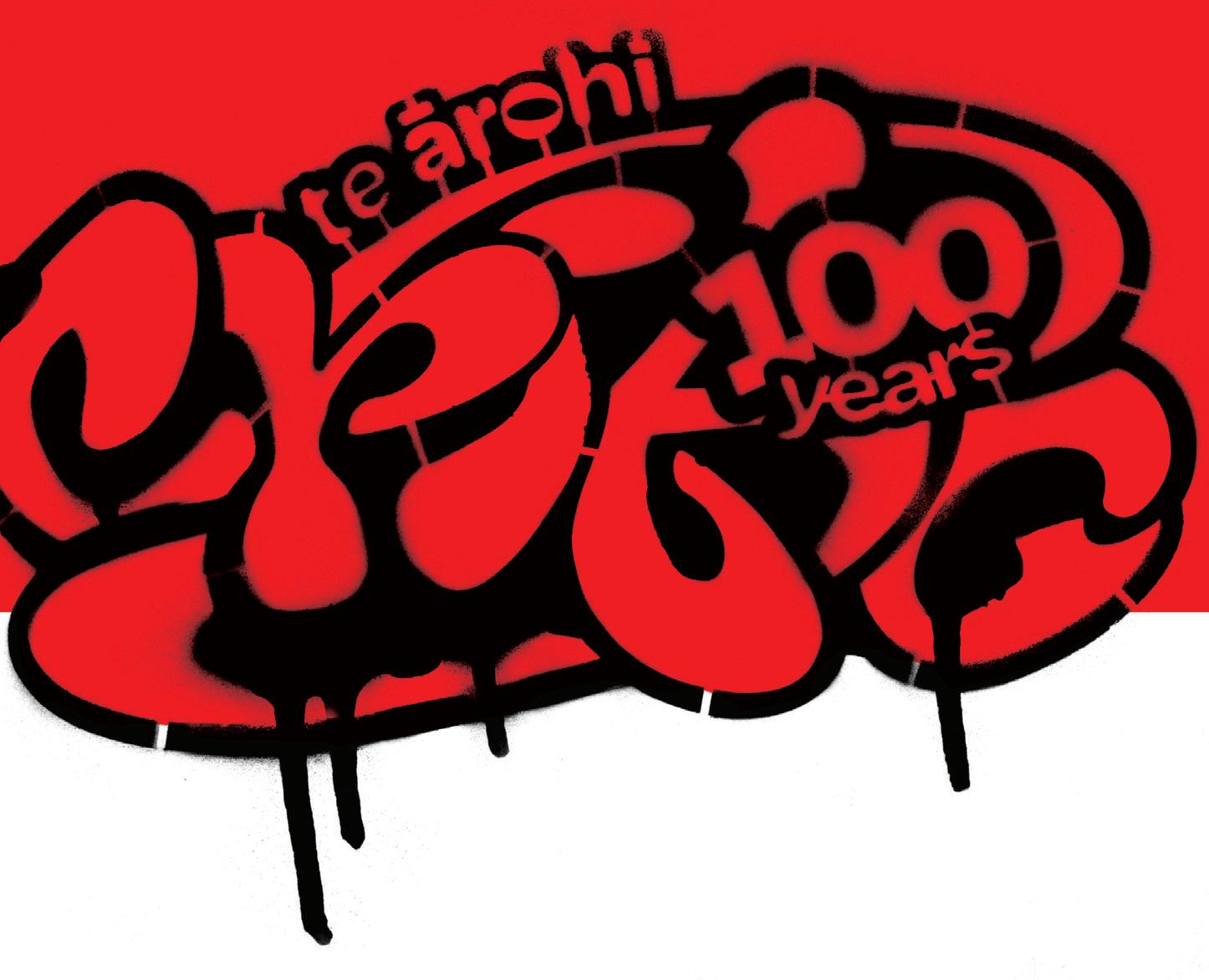

We did it so you don’t have to!

Choose your fighter: flip phone screen tattoo edition. Check out the new university logo that was predicted all the way back in 2003!


Fucking Balls? I barely know her!

Radio One tries not to make everything about them challenge! Level: Impossible.

Saving and waving!
Thanks for letting us know.
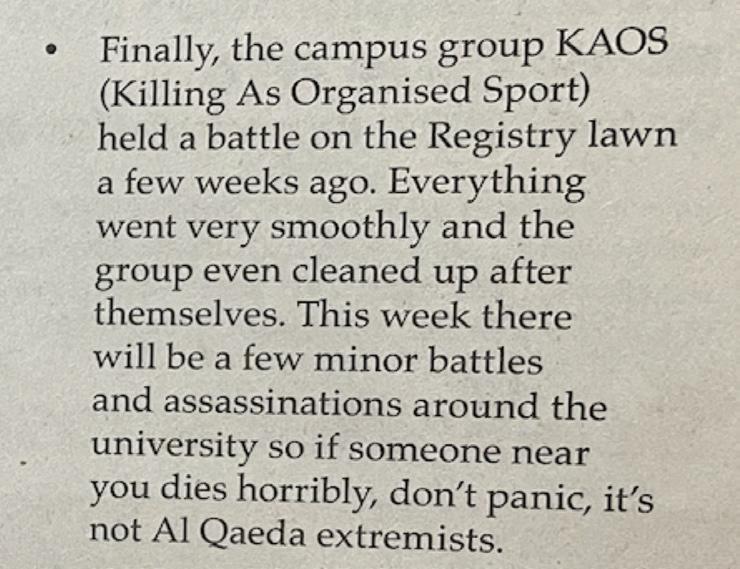




Many upset after Critic says, “Well, you’re not invited to my birthday party”
Within the past months many readers, staff, University affiliates, and OUSA, have been excited about Critic turning 100 years old, as well as the party that would come along with it.
Editor Nina had been overheard saying there would be “super cute party games” like pass the parcel, pin the tail on Seymour, and “that weird one where you wear a scarf and eat chocolate with a knife and fork.” VC G-Rob was particularly ecstatic about the promise of food at the event: “I LOVE fairy bread.” The hopes of Grant and many others were vanquished, however, after a series of arguments that concluded with Critic staff declaring: “Well, you’re not invited to my birthday party.”
The first argument broke out at the recent Market Day when Culture Editor Jordan was selling Critic tote bags and requested Limp Bizkit's ‘Break Stuff’ to be played by Radio One, who were at the stall next to them. “I would have settled for 'Rollin' or ‘Even Flow’ by Pearl Jam,” said a disgruntled Jordan. After being
By Billary Harry Shitposter // criticaltribune@critic.co.nz
denied by all members of staff, the invitation was revoked, resulting in a low morale within Radio One’s office. “We have been playing Jeff Buckley all day,” said Breakfast Show host Zac.
It has also been reported that many staff writers and contributors have yelled at lecturers, advisers, and group project partners that they would no longer be allowed to attend the event. “I got a B- instead of a B+ so they can suck it,” said staff writer Zoe. When reaching out to students about their lack of an invite many replied, “What’s Critic?” Critical Tribune can only conclude they are still hurt about missing out.
The party that is set to happen later this month is now expected to have an even lower turnout after disputes within Critic staff. Designer Evie reported that she was uninvited for “using that same font again” Evie expressed her disappointment saying, “Aw shucks.”






Sit a monkey in front of a typewriter long enough and it’ll churn out Shakespeare; put a bunch of Otago students in the same office for a hundred years and they’ll inevitably dig through the archives and compile it into a circle-jerk history of themselves – many times over. As the 93rd Critic put it in the last iteration, “We ran out of drugs to do, weird artists to interview and ways to make fun of commerce students.”
The centenary presents the ultimate excuse to cannibalise our own histories of our history. It’s time to park up on the metaphorical rug and listen (read) as Grandparent Critic (a collection

of past editors constituting the one identity) once again sits back in our chair with a huff, lights a cigar, and retells the same war stories. As far as we’re aware, there aren't any living editors pre-1952 to tell their stories, so we relied on the archives. The rest we’ve pulled from the 80th anniversary where editors contributed stories from the good old days, and added accounts from editors in the years since.
You may be left wondering how old Grandy has survived to a hundred through the trenches of University Council run-ins, successive defamation suits, censorship, rival publications,
By Nina Brown & Critic Through the Ages

resignations and firings, and budgets tighter than your mum. Maybe it was the undying love of grassroots journalism, wagging our fountain pens (now, keyboards) in defense of students and actually making a difference. Maybe it was the joy of reading angry (read: stupid) letters to the editor. Or maybe it was the free print night food and occasional campus clout. Humour us, will you?
Critic was founded in 1925, first printed on April 2nd (notably not April Fool's). Inaugural Editor Archibald Campbell’s editorial self-importantly touted ‘The Critic’ as a “necessary instrument” for criticism, an endeavour that Archibald (imagine screaming that name in bed) boldly claimed should have the “wholehearted support of every student”. While the publication itself was a fairly dry newsletter detailing clubs’ goings-on – largely penned by Christian sport-loving Med students who debated literature, it seemed – the letters to the editor kicked off within a few issues.
Two letters were especially potent. One complained about how, in the author’s humble opinion, “medieval maiden” needed to be reminded of their place; a formerly “divine creature” content to “keep a good man and rear a good family, now ramps and roars on the public platform as a candidate for public offices better filled by men.” Other letters predicted The Critic would be a miserable failure like its predecessors, Review and Te Korero, the latter of which had fizzled out. In an editorial 93 years later, then-Editor Joel MacManus wrote a “big fat Fuck You” to those haters.
The Critic had a cute new look in the ‘30s, shifting from its quarterfold (the same it is today) to a newspaper, a look better fitted to the fedora-trenchcoat-wearing aesthetic on campus. Magazines just don’t say “Great Depression” like a good broadsheet. Outside of running comics by Peter McIntyre (who would later become New Zealand’s official war artist in World War II), launching novelist Dan Darin’s career, and a letter to the editor proposing a ‘Rhythm-maniacs’ gramophone appreciation evening, the 1930s also saw their fair share of controversy. No issues were printed in 1932 for two months after some tongue and cheek coverage of Capping stunts wound up getting the editor expelled. Five years later, the OUSA Exec’s radical censorship of Critic saw the resignation of the entire Critic staff. Production ground to halt in 1939, well before the year's end, and did not resume again until 1940. Other than that, not much to report – or people to report, rather.
The first editorial in 1940 stated the newly resurrected Critic’s aim (after the topsy-turvy ‘30s): “To help in the war effort by refraining from subversive criticism and by welding together student efforts and opinions in any campaign or scheme for assistance in the war.” While World War II naturally dominated a decent chunk of the news cycle in the ‘40s, the magazine remained fairly campus-based and insular. There was surprisingly little
coverage of key events – Hitler’s death didn’t even get a mention.
The war became real for students when the University of Otago encouraged conscription, a stance that attracted a walloping of opinion pieces. Students’ political engagement may be more slippery than black ice on Clyde Street – but they were paying attention to this. One issue featured an exploration of the civil rights of conscientious objectors.
As the campus emptied of men, women began to fill previously male-dominated spaces, including newly appointed female acting Editor Diana Shaw who relished in the opportunity to slam men who complained about women wearing pants on campus: “Our ire can no longer be restrained. It is the pettiness and the stupidity and the narrow mindedness of men of your ilk which have caused women to be relegated for so long to the subordinate position from which they are slowly emerging.”
If you think modern-era Critic comes with whiplash –where issues can contain both an eight-page deep dive investigating drink spiking and an editorial petitioning for a sexy Garfield illustration to be freely available to students – the 1940s took it to the next level. Amongst reports of former Otago students fighting in the war, extending its sympathies to those who died, there was also a paparazzi-esque gossip column with photos of students about town: on the sauce, pashing for the camera in an age where they didn’t have to worry about a digital footprint.
Our oldest living editor, Dr Paul Oestreicher, was at the helm of Critic in 1952. In a reflection published in the 80th anniversary edition, Paul recalled that the poetry was great (some by the prolific James K Baxter), the illustrations witty, and the politics controversial enough for the “conservative ODT” (who printed Critic at the time) to refuse to print an article on the Korean War – so the front cover was left blank: “CENSORED!” Paul reflected to 2005 Critic on how student journalism had “matured” in the 53 years since, signing off his reflection by addressing the Editor at the time directly: “I wonder, Holly, what you will think of Critic 2005 in 2025? I hope and pray that you and your gang will get together to celebrate the first century. Speight’s will still be the best drink.”
What Paul failed to mention was that, aside from deliciously introducing the first “purely puritan” sex themed issue – a move that saw other student publications follow suit – pages of ‘50s Critics were filled with tales of alcoholism that would rival the modern coffin-sinking breatha. A Critic reporter in 2018 labelled the ‘50s as the “ultimate binge-drinking era” after unearthing stories of one guy who tried to blow the froth off his medicine in the hospital; a party with 28 beers budgeted per person (which apparently was being stingy); and a club exclusively for binge-drinking. Said reporter cheekily pointed out that clubs nowadays just “use an existing hobby as an excuse to binge drink”. The Ski Club’s Tour de [REDACTED] would never.






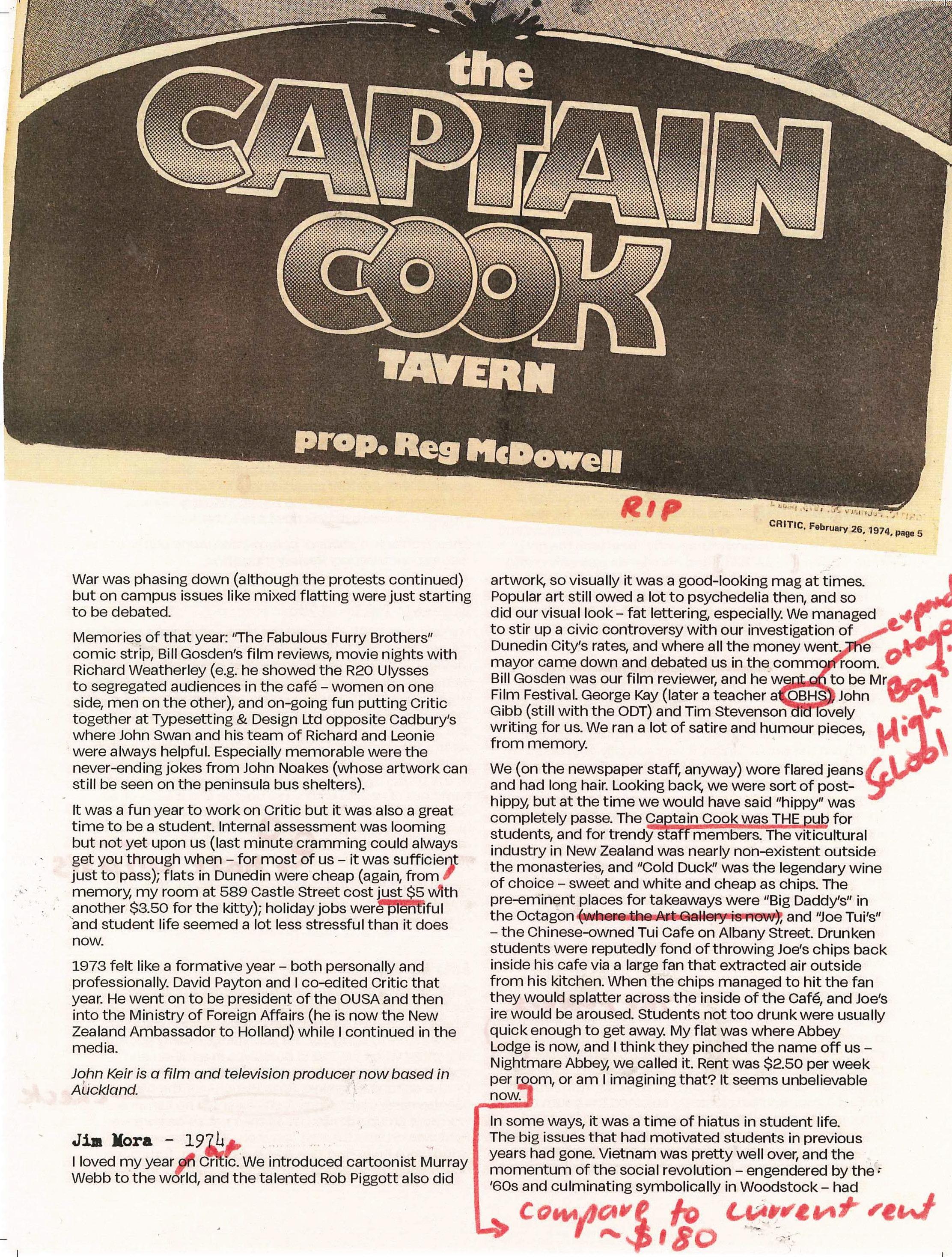




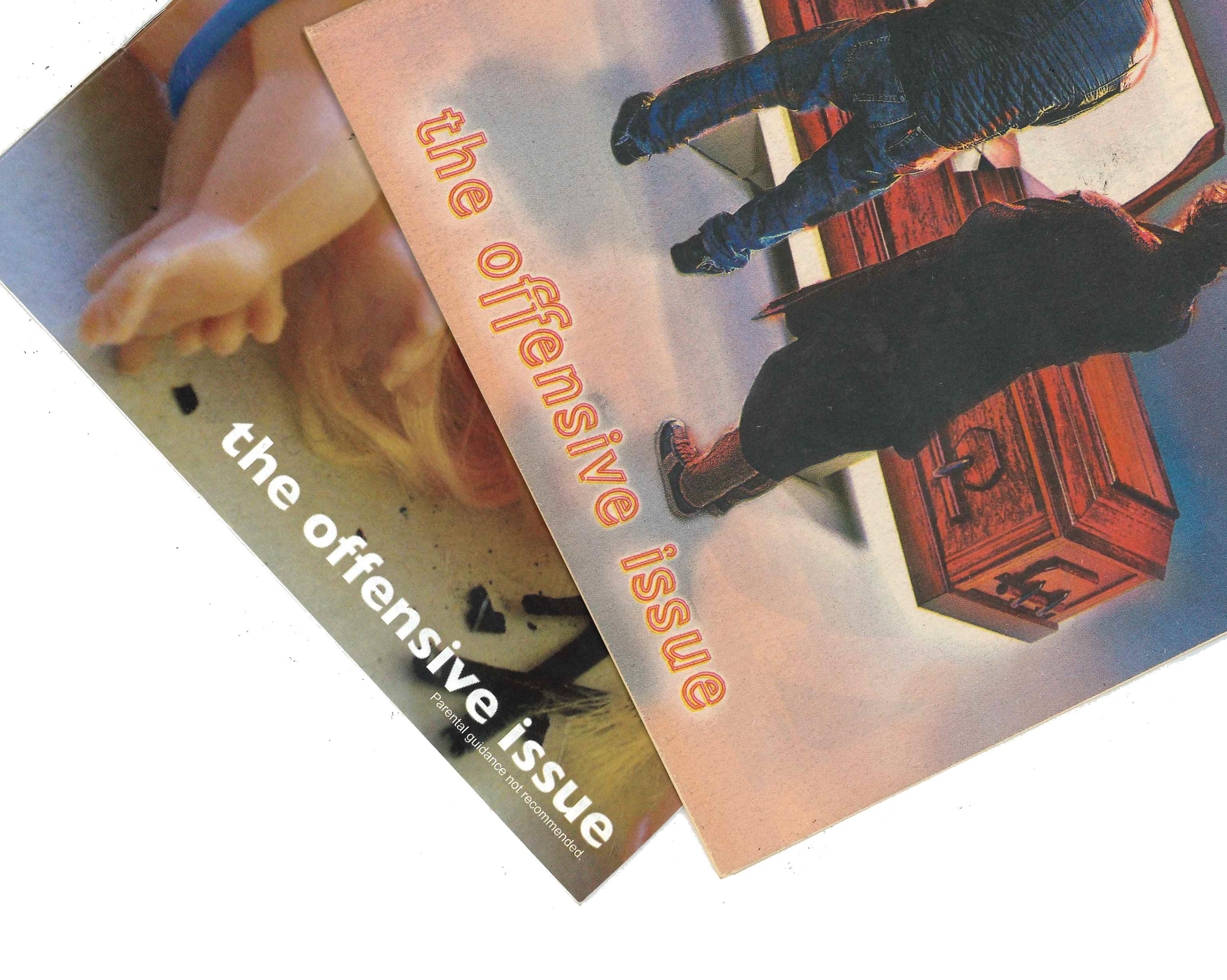

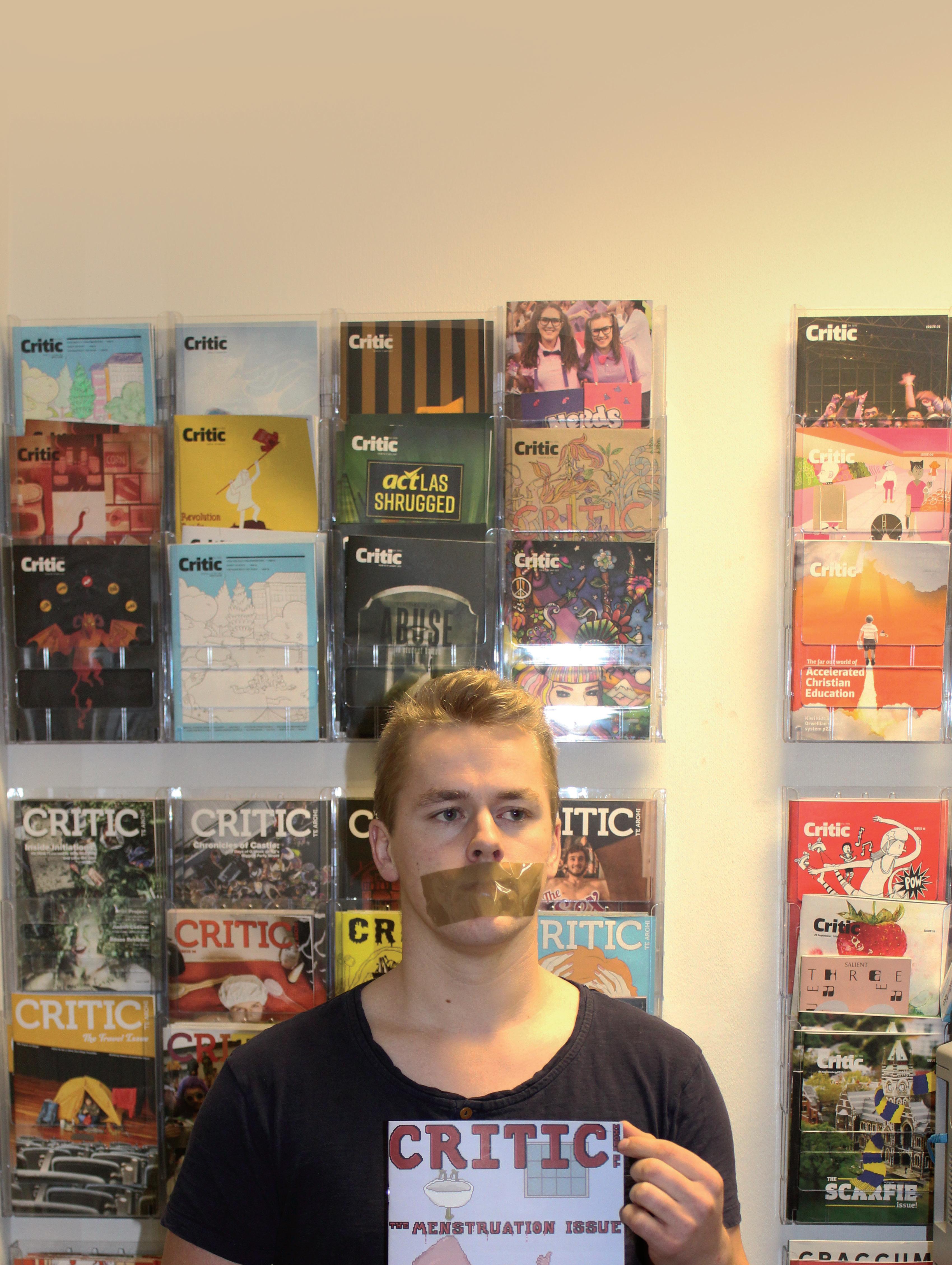





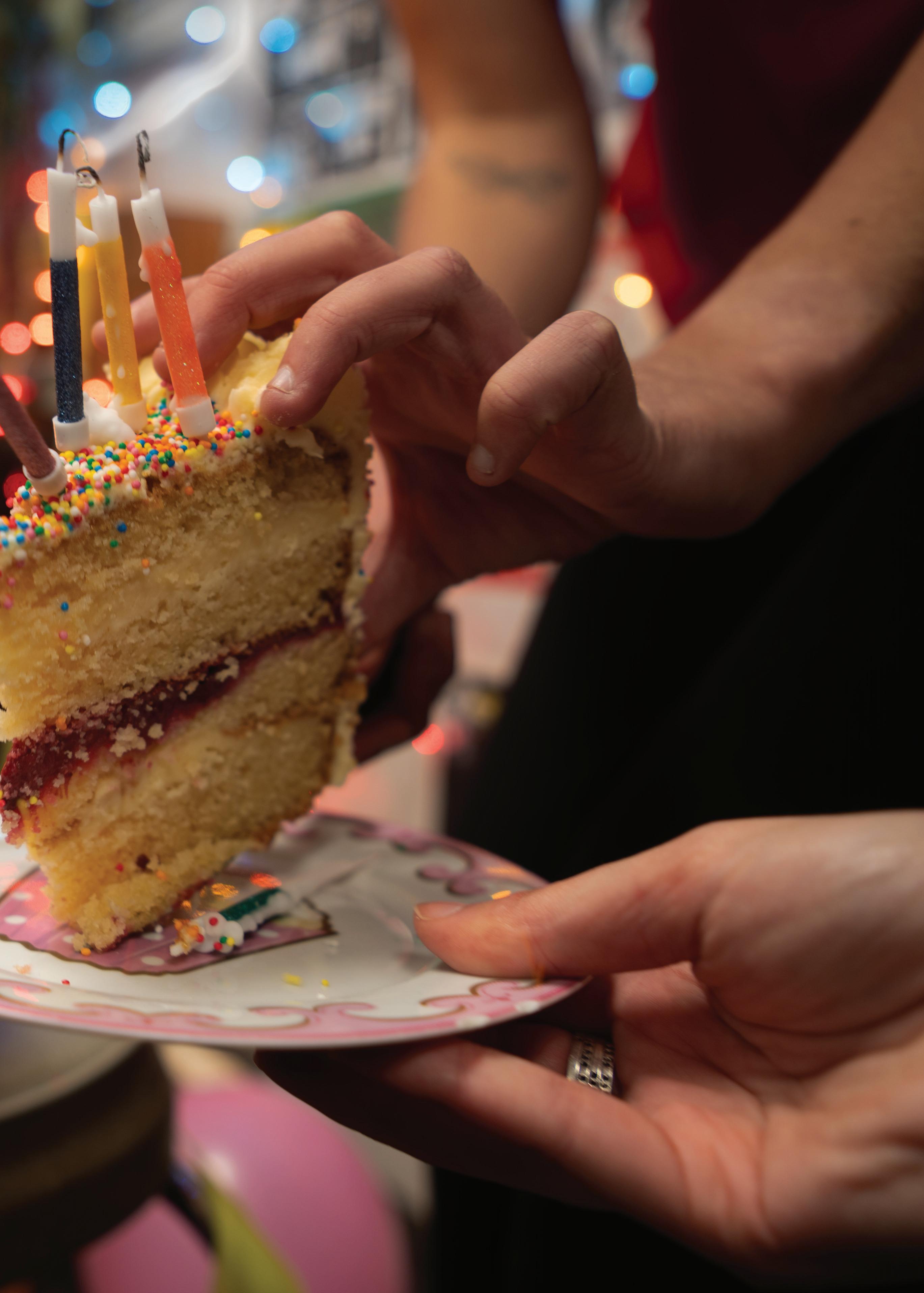
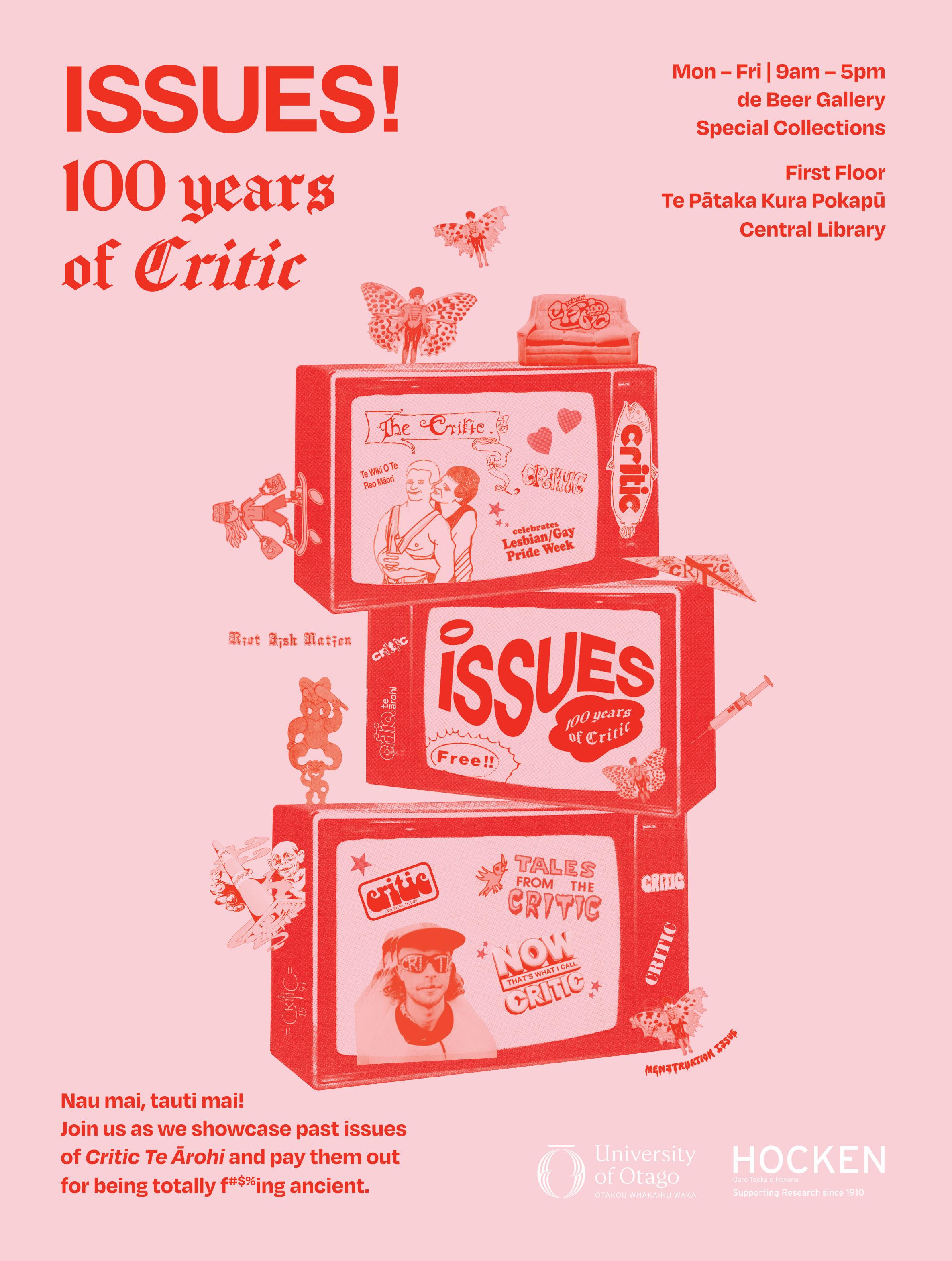
Special thanks to the Hocken Library who house every issue of Critic Te Ārohi extending back to 1925. Without them, Critic’s history, beyond our scuffed website, would not have been preserved. Visitors to their ISSUES! 100 Years of Critic exhibition are invited to contribute when visiting the gallery by handwriting or typing a letter. The winning letter of the week will be featured in the magazine and the author gets a free Critic tote bag! Email critic@critic.co.nz to claim your prize.

When Māori were a headline, the punchline, or nowhere to be found

This piece was pitched as ‘100 years of Critic’s Māori coverage’. That would’ve been disingenuous. It’s not a centenary for all of us, because for most of that time, we weren’t here.
One hundred years of Critic, and only twenty-nine of Te Ārohi. That’s how long it took for Māori to even be acknowledged in the name of Otago’s student mag – after 71 years of printing, publishing, and running its mouth without us. And while the name change in 1996 was a long-overdue nod to te ao Māori, it didn’t erase the decades of silence, stereotyping, and straight-up racist rubbish that had already been slapped onto its pages

For most of Critic’s century-long run, Māori in the media have either been a headline, the punchline, or nowhere to be seen. When we weren’t being ignored, we were being debated, dissected, or dismissed – our language up for discussion, our tikanga misunderstood, and our political movements painted as radical disruptions rather than necessary resistance. The magazine, supposedly forward-thinking, sat silent through it all. Let's also not forget the golden era of Māori caricatures, clueless opinion pieces, and the ever-popular “should te reo Māori be compulsory?” debate (spoiler: yes, and you’re already decades late).
Yes, Critic has changed. But has it changed enough? And more importantly, does a century of student journalism really deserve celebration when Māori voices were rarely considered for most of it?
In Critic’s first few decades, the absence of Māori voices was deafening. It was as if anything remotely Māori didn’t exist within the walls of Otago Uni, despite Māori scholars, activists, and students moving through those same spaces. When we did show up, it was through a Pākehā lens – anthropological, academic, or observational. Take ‘The Niue Island Case’ (March 18, 1954) as an example.
While not inherently about Māori, its framing reflected the same colonial gaze that shaped Māori representation in the media of its time. Niueans were spoken of as subjects of white tutelage, with New Zealand positioned as their moral and intellectual custodian, declaring itself responsible for “educating these people to accept white standards of behaviour.” Niueans were described as “somewhat primitive and superstitious,” with patronising observations about their attitudes toward work and food – deemed “touchy” and irrationally important to their worldview.
For all its talk of being progressive, Critic spent the majority of the 20th century proving absolutely otherwise. Even in the 1950s, it threw around the N-word like casual punctuation (June 11, 1953), scoffed at the idea that women deserved both pay increases and basic respect (March 18, 1954), and – in a truly unhinged take – gushed over Israel’s ‘successes’ as a nation built by sheer determination, conveniently overlooking the terrorism, displacement, and colonial violence that made – and continues to make – that possible (October 2, 1952). Perhaps the writer saw something familiar in that story –after all, Aotearoa knows a thing or two about a country ‘settled’ through the same means.
This selective blindness wasn’t just limited to international issues. Even when Critic took a stand against apartheid in South Africa, it failed to connect the dots to racism

at home. Throughout 1981, in a year dominated by the Springbok Tour protests, Māori were barely a footnote in Critic’s coverage. There was one brief mention of Māori and how they were affected by the infamous Springbok Tour, and reference to the previous tours – mainly the 1970 one where the Māori players were classified as “honorary whites,” but otherwise Māori involvement, despite being central to the protests, was erased. And while Critic did their due diligence to report on the atrocities taking place in apartheid South Africa, they failed to make the connection on how it mirrored race relations within their own country. The film Uproar captures just how deeply Māori were involved in the anti-tour movement, drawing from the director's own experiences at the time. Even Greg McGee’s Foreskin’s Lament, a 1980 play that predicted the tour’s impact on race relations in Aotearoa, got a Critic review mid-protest, with no mention of Māori at all.
As subjects of curiosity, rather than contribution, there was no platform for Māori perspectives, and certainly no acknowledgment of our political realities. Instead, Māori were a footnote in a magazine that prided itself on being forward-thinking.
For a magazine called Critic, it spent decades failing to be one when it mattered. Even in the last 30 years, when Māori issues were impossible to ignore, Critic largely managed to do just that – staying silent when it could have spoken up, or at the very least, asked better questions. Researching this piece felt like sifting through a black hole – not because there was too much to unpack, but because there was barely anything there. The sheer, overwhelming absence of Māori representation in Critic’s archives wasn’t just frustrating, it was telling. Critic is great at asking hard questions. Just never about itself.
When Māori did make it into wider media, it was rarely to celebrate our achievements or perspectives. Instead, we became headlines when we were newsworthy in ways that served a Pākehā gaze. Actions were framed as controversies, moments scrutinised, and voices only amplified when Pākehā commentators could dissect them. Protests for Māori rights, such as the 1975 Māori Land March and the 2004 Foreshore and Seabed hīkoi, were framed as dramatic spectacles rather than legitimate acts of resistance. More recently, coverage of Ihumātao and marches against the Treaty Principles Bill followed the same pattern, centering disruption over cause, reaction over resolution. When Māori lawmakers performed a haka in Parliament to oppose the same bill, media fixated on the ‘outburst’ rather than the build-up behind it.
Māori activism on campuses all across the country –whether it was protests, the fight for te reo Māori, or the push for tino rangatiratanga – was painted as radical and disruptive. The 1979 Haka Party Incident is a prime example. For decades, Auckland University engineering students performed a mock haka during Capping week, donning grass skirts and caricaturing Māori culture. The university dismissed these performances as “too trivial a matter to investigate”, despite repeated objections from Māori students. The activist group He Taua confronted the engineering students, leading to a brawl in which eleven members of He Taua were arrested. The Auckland Star sensationalised the incident, framing it as violent with
the headline, “Gang Rampage at Varsity Leaves Students Battered,” rather than addressing the racism that sparked it. Treaty stories were often accompanied by a ‘both sides’ framing as if the rights of tangata whenua were up for debate – just look at the media coverage of the Treaty Principles Bill. Headlines like “New Zealand rocked by indigenous rights controversy” (GZERO, 2024) implied there was a valid argument against Māori sovereignty. When Māori students did succeed, we were treated as anomalies, exceptions rather than the norm. The racism faced by Māori medical students was widely covered (“Auckland Māori medical students sick of entry requirement racism”), yet their achievements in the field were rarely given the same platform. That isn’t to suggest that Māori excellence stories don’t exist; anyone who’s scrolled through Facebook comments knows how quickly it gets dismissed as “special treatment”. When New Zealand’s largest media outlet, Stuff, issued an apology in 2020 for its racist reporting, the headlines focused on media self-reflection rather than the damage done (“New Zealand media giant Stuff apologises for ‘racist’ past reporting”). These patterns aren’t accidental, they reflect an ongoing narrative that positions Māori within the media only when it suits a Pākehā lens.
It’s a pattern that Critic has followed for years. When it comes to Māori issues, the choice has always sat somewhere between bad coverage and no coverage at all. Even up into the recent decade, Critic’s efforts for Māori Language Week have been, at best, minimal. A tokenistic headline here, a surface-level feature there – but never a full embrace of the kaupapa. It wasn’t until very recently that te reo Māori or aspects of the Māori worldview have started to be seen as something more than a once-a-year obligation, and even now, there’s a long way to go.
The contrast is even sharper when we look at other student publications. Just look at ‘Te Ao Mārama’, the dedicated Māori edition of Salient magazine – first introduced in 1973 and eventually enshrined in VUWSA’s constitution from 1997 onward. It isn’t just a one-off effort, but an entire issue led by Māori writers, editors, and artists, creating space for Māori voices. Meanwhile, Critic has struggled to offer even a fraction of that commitment.
For a time, Māori content was confined to a designated column, a box to be ticked rather than an integrated voice within the publication. Articles on Māori issues would surface sporadically, usually tied to Māori Language Week or major political events, but a consistent presence was harder to find. Critic’s disconnect from tauira Māori was so glaring that they resorted to Facebook callouts, scrambling for Māori contributors specifically for Māori Language Week. It wasn’t until 2018 onwards that Māori contributors began to carve out a more permanent space, pushing boundaries and stirring the pot. Prior to that, Critic had been otherwise silent, without so much as a nod to Te Wiki o Te Reo Māori.
The tide began to turn when Māori students refused to stay
quiet. Māori contributors started claiming space, pushing back against Critic’s history of exclusion and taking control of our own narratives. The renaming of Critic to Critic Te Ārohi in 1996 under Editor Tracy Huirama-Osborne was a beacon of change, but the mahi wasn’t done. While te reo Māori found its way into articles, perhaps at first as a token gesture, it soon became an essential part of storytelling. This wasn’t just a shift in what was being covered, but who was telling the stories.
Even in the 2010s, Critic’s engagement with Māori content remained inconsistent. Māori activism and issues were still largely absent. In 2019, Critic Te Ārohi published Tiana Mihaere’s “Why We Must All Protect Ihumātao”, a rare and powerful call to action that centered Māori voices in the struggle against land confiscation. The following year, Annabelle Vaughan’s “A Seat at Our Table” exposed the constant scrutiny Māori students face in academic spaces, followed by her article “Minorities in Medicine”, which tackled the University’s proposed cap on Māori and Pasifika medical students – an issue that went largely unchallenged in mainstream media.
By 2020, the new wave of Māori contributors was bringing fresh perspectives to the table. Kaiya Cherrington explored topics such as the isolation of being Māori in a predominantly Pākehā student town (“Māori Migration to Otago Uni”) and decentering colonial ideas of womanhood (“Colonisation made periods gross”). Others laid bare the everyday challenges faced by tauira Māori navigating a system never built for them, the lack of Māori spaces on campus (“Why Otago University Needs A Marae”), and the journey to reclaiming the native tongue (“Learning Te Reo Māori as a Māori Student”).
These stories weren’t just filling a diversity quota – they were holding up a mirror to student media, and shifting the narrative on what Critic could and should be: forthright, fearless, and unapologetic.
By Nina Brown Illustrated by Tevya Faed
One of the most significant shifts in Critic Te Ārohi’s 100year history has been the emergence of the Kaituhi Māori role, now known as Ētita Māori, which was established in 2022. This role signaled a move from tokenistic, sporadic inclusion to real structural change. No longer was Māori content an afterthought or a once-a-year obligation. Ironically, it was an American editor who finally made it happen. According to Fox Meyer (Editor-in-Chief 20222023), the decision was a no-brainer. “My decision to make this position wasn't that deep. I noticed it didn't exist, thought 'wow, that really should exist', and then made it exist,” he said. Fox explained that while previous editors had recognised the need for such a role, the magazine’s rapid turnover meant no one had the time to formalise it. “I knew it was something that needed to be done when I started running the mag, so I made it happen right away. Some things just need to happen, and this was one of them.”
But let’s sit with that for a second – it wasn’t Critic that saw the gap and acted. It wasn’t a long-overdue internal reckoning. It was someone who saw the importance of the Māori voice with fresh eyes and, crucially, had the power to fix it. Until then, Critic barely acknowledged te ao Māori at all. Before 2022, articles about the Māori experience, language, and worldview were a rare novelty rather than a
regular feature. No one had time? No, Critic just didn’t make the time – until someone finally did.
Critic Te Ārohi is no longer the publication it was a hundred years ago – or even thirty. Māori voices are here, our stories are being told. But let’s be real; progress isn’t the same as justice. Having a Māori name doesn’t erase decades of exclusion or being an afterthought.
It’s not just about visibility or consideration, it’s about power. Who holds the editorial reins? Whose voices shape the narrative? Is te ao Māori embedded in Critic Te Ārohi, or is it still tacked on when convenient? These are the questions that matter, and yet to be answered. Nearly one in five New Zealanders is Māori. In theory, one in five pages of Critic should reflect that. But here’s the thing – Critic has the chance to be more than just a reluctant participant in progress. No matter how many first-place awards the mag wins, it won’t mean much if it’s still coming second where it really counts. Why not push for a section specifically dedicated to te ao Māori? Why not do a Salient and enshrine the Māori Language Week issue into the OUSA constitution? If Critic Te Ārohi is serious about shifting from tokenism to transformation, it needs to stop following and start leading.
These stories weren’t just filling a diversity quota – they were holding up a mirror to student media, and shifting the narrative on what Critic could and should be: fearless,forthright, and unapologetic.

Critic’s had haters in our inbox right from day dot. Within the first few issues in 1925 there were letters predicting Critic’s downfall. Now in our 100th year, let’s have a toast for the douchebags, assholes, scumbags and jerk-offs who’ve penned objectively hilarious and sometimes on the money vitriol against this humble mag. Bring back tradition morals and faith again.
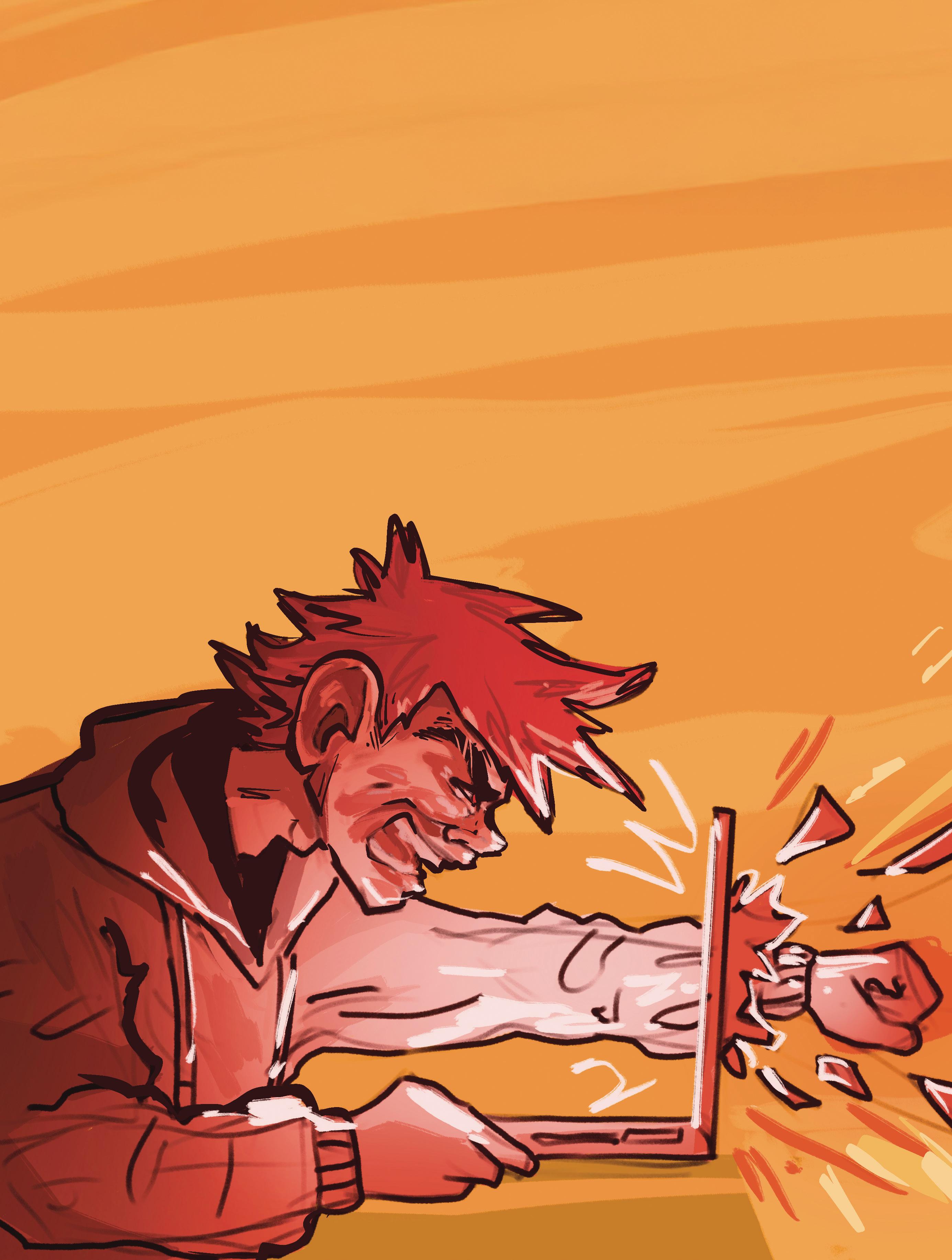



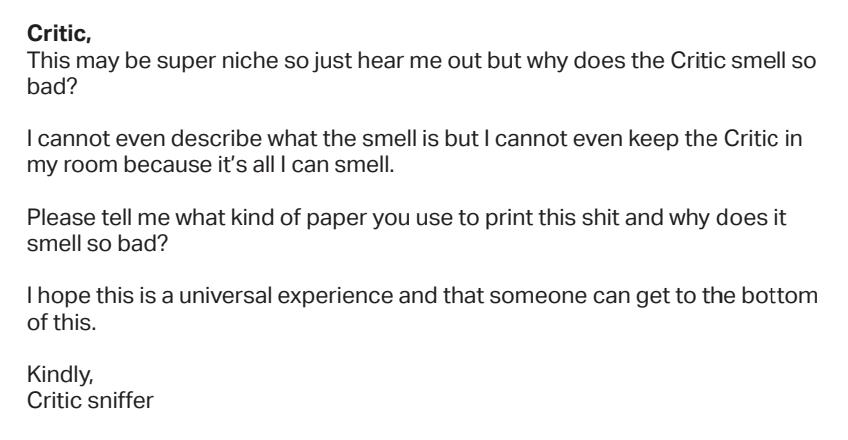

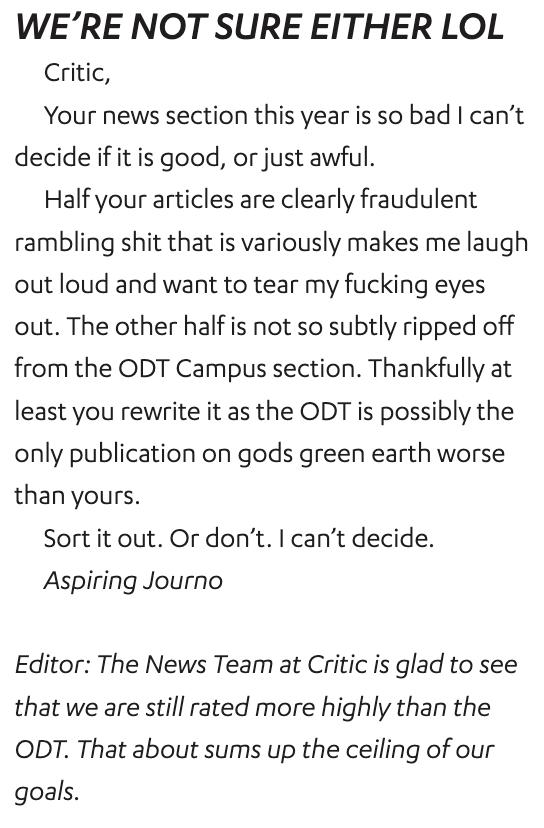





By Tevya Faed



In a feat of technical genius that sent its maker loopy, Critic brings you an origami Clocktower Bong (“Clong”) modelled off the 3D-printed original tucked safely away in the office. The first person to send us proof via Instagram DM (@criticmag) of an assembled Clong wins a free Critic tote bag!
1.Critic is the school lunch programme of student magazines.
2. Students are out of touch with what young people want.
3.It lacks the intellectualism of Salient.
4. It should really just be a TikTok account by this point.
5. Critic’s definition of high brow is shaving its pubes.
6. Critic secretly voted for Luxon.
7.Its best features are its ads.
8.It has too many ads.
9.The horoscopes are undercover lifemaxxing.
10.Since the advent of the iPhone, it’s lost all its utility as toilet reading.
11. It can’t hold a clip of bullets for shit. Oh, no, wait— that’s a way Critic is the worst ammunition magazine in the world.
12.Snap of the Week smells like parental neglect.
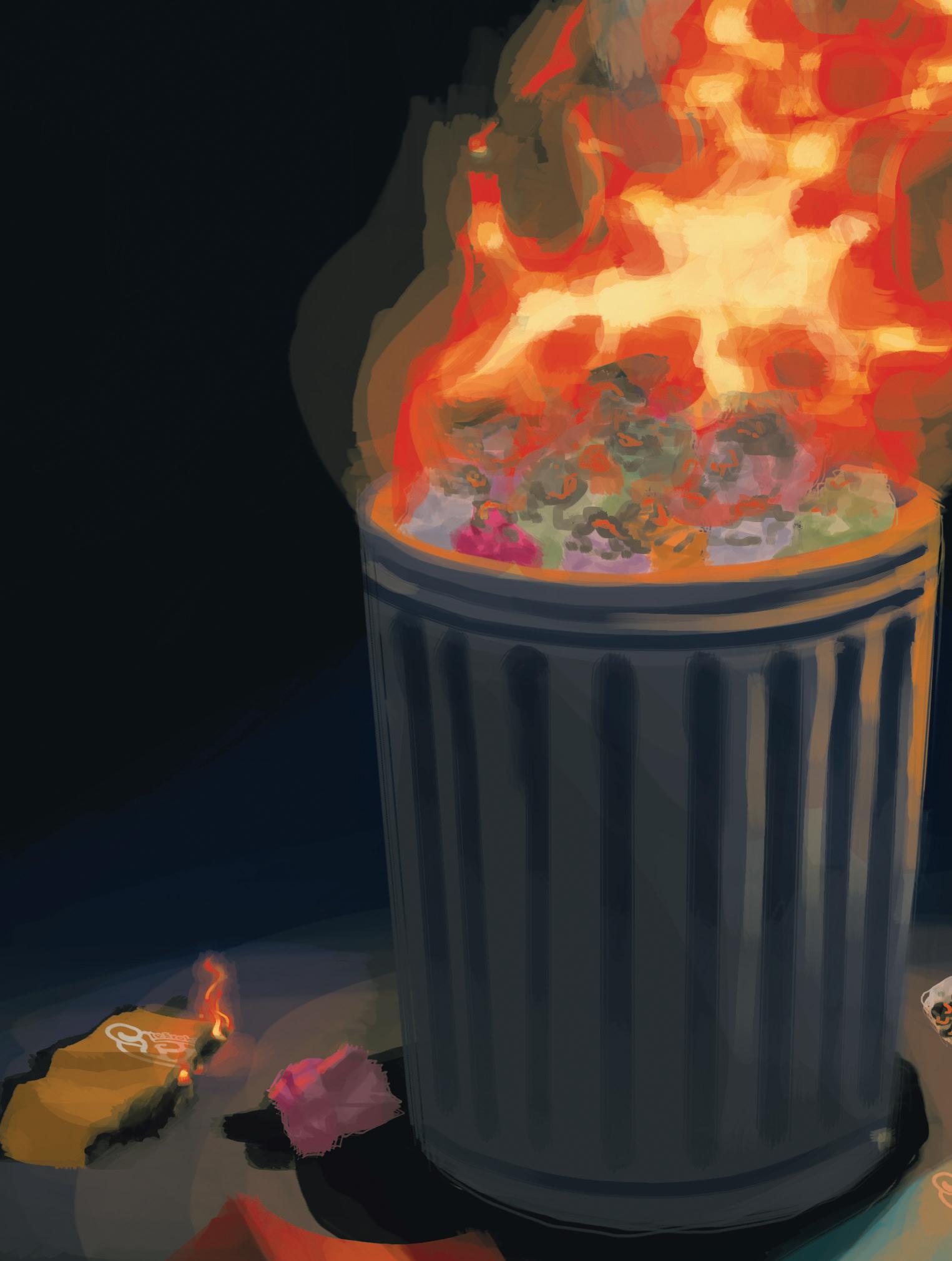

40 Ways was Critic’s weekly listicle, popular in the early 2000s and maybe even the 1990s – the halcyon days when men were men, women were women, men were also women, women were also constructs,gender introductoryand blurbs were worth reading.
13.It lacks the punk anarchy of Craccum.
14.It should really just be an OnlyFans account by this point.
15.It’s far too slender and thinskinned to survive in marshy waters and doesn’t demonstrate any of the necessary sense of touch needed to grow into a fully mature sea cow. Oh, no, wait—that’s a way Critic is the worst student manatee in the world.
16.Its writing fucking sucks.
17. It has been unreadable since drinking was banned in Dunedin.
18.It should really just be a neural implant by this point.
19.
It is utterly useless at providing actionable information for where to safely bang nails into the wall from which to hang framed art. Oh, no, wait— that’s a way Critic is the worst stud magazine in the world.
20. It’s all political correctness gone mad.
21.It’s all political madness gone correct.
22.The Booze Review is triggering for uncool losers who don’t drink.
23.Just admit you stan the ODT, Critic.
24. Daddy Grant’s middle name is Murray.
25. It’s Radio One for book nerds.
26.You’re a failure and a loser, your life is shit, and it’s all you deserve.
27.
Issue 3, 2025, page 12 - an embarrassing grammatical error in the subhead. Classic example of a plural pronoun not agreeing with its singular noun antecedent.
28. It lacks the proud parochialism of Canta.
29.Pervasive left-wing bias on the puzzles pages.
30. Visit critic.com and you’ll see.
31. Its reflexive - and, frankly, tired - criticism of mainstream media makes it just like Reality Check Radio.
32.A lady editor?!
33. It’s a fact that all Critic readers are virgins.
34. What’s Critic doing to stop the creeping advance of populist autocracies?
35. It’s clearly written by ChatGPT.
36.This magazine is so Dunedin, I half expected it to come with a free puffer jacket and a pack of Speight’s.
37. ChatGPT wrote that last joke.
38.You can’t spell “Critic” without “it sucks.” The second word is silent.
39.It can’t even count to 40.





TUESDAY 8 APRIL
THURSDAY

WEDNESDAY 9 APRIL


SUNDAY

RHYTHM
1 Mim Jensen (NZ) - Safe in Body No. 9 last week | 3 weeks in chart
2 SODA BOYZ (NZ) - Enough No. 10 last week | 2 weeks in chart
3 U-No Juno (Dn) - Velvet No. 5 last week | 3 weeks in chart
4 Ani Saafa (Dn) - Gripes No. 1 last week | 5 weeks in chart
5 Vera Ellen (NZ) - Sangria No. 2 last week | 3 weeks in chart
6 There's A Tuesday (NZ) - Margo No. 4 last week | 5 weeks in chart 7 Bunchy's Big Score (Dn) - White Noise No. 6 last week | 4 weeks in chart
8 George VILLA (NZ) - Keep It All Together 1 week in chart
9 L. Hotel (Dn) - Dead Ends No. 8 last week | 6 weeks in chart 10 Coin Laundry (NZ) - Worm in my Ear No. 3 last week | 3 weeks in chart 11 Fouler (NZ) - Shortening 1 week in chart

Special thanks to our Critic birthday sponsors*! If you would like to be involved in the Critic Te Ārohi centenary book project, make a pledge by scanning the QR code or get in touch with 100@critic. co.nz – be part of history.
Zane Pocock
Liam White
Sinead Gill
Zachary James Hoffman
Henessey Griffiths
Imogene Felton
Miffy Stuart
George DeMarco
Flynn Robson
Elliot Weir
Quintin Jane
Bridie Lloydd
Denzel Chung
Nina Brown
Eden Bennett
Olivia Restieaux
Bonnie Harrison
Caitlin Knox
Annabelle Parata Vaughan
Ezra Dempsey
Emily Taylor
Lily Knowles
Lucy Leadbeater
Taine Duthie
Jimmy Langrish
Mario Girardet
Francisco Bagkus
Hernandez
Tara Shepherd
Sophia King
Maddie Hall
Romy Wales
Hanna Varrs
Accalia Guilford
Connor Moffat
Gemma McKinney
Harrison
Lia
Brynn McBurney
Helena Hornbacher
Rose Mills
Brooke Henderson
Sebastian Rhind
Oliver Simcock Smith
Emma Kehely
DIVISION OF EXTERNAL ENGAGEMENT
Ella Grayson
Grace Thompson
Tamsin McCallum
Rosemary Overell
Jack Ure
Jamison White
Ryan and Amanda Brown
Isaac Douglas
George Bysouth
George Kennedy Hargood
Gryffin Blockley
Alix Long
Maia Ingoe
Paris Henderson
Aletheia Goh
Sara Luzia Rothwell
Jack Fraser
Pippa Thompson
Josh Martel
Emma Westenra
Finn Cattaway
Lucy Mckenzie
Kelly Ngan
Daniel Leamy
Natasha Howie
Sophia Carter Peters
Jamiema Lorimer
Jonathan McCabe
Reuben Ballara
Animesh Tripathi
Kelly Stitely
Matilda Rumball-Smith
Emma Brown
*Note: This list excludes those who have made direct donations to OUSA outside of the pledge form. We love and appreciate you too xo
The legendary Crown Hotel is still shaping Ōtepoti’s live music scene. The bar and music venue hosts local, student, and international musicians. A quick nosey around the pub gives you a sense of its history. The jukebox displays the owner’s extensive music collection, meanwhile holes in the centre of high top tables mark where ashtrays used to lie – relics from the era when it was normal to smoke inside.
The pub can be found on Rattray Street, in between the Speight’s Factory and the Grand Casino. Folk, metal, punk, and surf rock scenes all find refuge in this isolated strip of town. Three members of the Chin family purchased the spot together back in 1989. Critic Te Ārohi caught up with its proprietor Jones Chin to understand a bit of The Crown’s history.
Ōtepoti's live music industry is nothing short of relentless. In an era where bar owners change hands more frequently than Critic readers turn over pages to find the horoscope, The Crown Hotel offers a little bit of consistency. Jones was proud to call it "the longest running pub in Dunedin" to still retain its original name.
Jones was really excited to show Critic a photo of the building when the bar first opened in 1861. Pictured were the original foundations supporting the now iconic Crown logo. This was 15 years before the first Speight’s was brewed across the road (clearly a prideless South). The Crown still remains open seven days a week.
Jones is part of a line of Dunedin royalty. An overarching mural of Jones' grandfather Chin Fooi covers the entire outer-back wall of the pub. The two story high artwork was painted by Stickum, an artist co-op, to commemorate the Māori and Chinese roots of the area. A caption at the bottom of the mural tells us that "Chin Fooi's laundry opened in 1920" on Rattray Street. Jones' father Eddie Chin later transformed the street into a nightlife hub in the 1960s and ‘70s when Sunset Strip and Tai Pei cabarets were at their peak.
In the early 1980s, Jones' brother Sam Chin bought the Majesty Theatre, found sandwiched between State Highway 1 and Vogel Street. With the help of Jones, they transformed it into the nightclub called Sammy's. The light blue façade housed a pivotal venue for the jangle pop genre known as The Dunedin Sound. A period that gave Ōtepoti international recognition in the ‘80s and ‘90s. Jones spoke of larger gigs attracting over a thousand people, specifically mentioning that more connected bands like The Chills would always have a “guest list of a 100, maybe 120 people.” The earthquake-damaged and asbestos-ridden hall now lays dormant in the hands of the DCC, waiting to be repaired.
Jones took over The Crown Hotel at what he called the "toe end" of the Dunedin Sound, remembering that "The Verlaine's played a lot, and so did The Bats." He has now plastered the walls with posters of musicians that performed at either Sammy's or The Crown. In our conversation he takes a moment to point at the recently deceased musicians whose names line the walls. He soberly notes that "Martin [Phillipps] has just passed away, Peter Gutteridge passed away a few years before that, and [a few years prior] Hamish [Kilgour] passed away too.” These members of iconic bands The Chills and The Clean were all once friends of Jones and contributors to the scene he helped cultivate.
Student band, The Audio Visual Drop Kicks (AVDK) recently wrapped up their ‘Betterland’ Aotearoa tour at The Crown. Singer and bassist, Jeremy loves that "whenever you go to a show at The Crown, you know that every single person is there for the music." Because it is so far away from Studentville "you don't get many people that just stumble in." Jones agrees that people who visit for live music are respectful. He was shocked that over the last decade, only three beer jugs had been stolen. He reported that "just a few dozen" pint glasses had been lost or destroyed (don't tempt us). To compare, U-Bar has lost over 2500 glasses in the past few years.
Jones took Critic behind a locked door to reveal an old extension of the bar. The space is now filled with broken furniture, pool tables, and posters. All artists that passed through The Crown pre-2009 used to perform here. Jones reminisced about the night when '90s Wellington band Head Like a Hole opened for Shihad. This was when they first "began performing nude." After stripping, the band headed to the stage. The stage manager locked the stage door behind them, forgetting that the butt-naked drummer was left outside. No one could hear him banging on the door because the bar was too noisy. As Jones told it, the drummer "had to go out the back door, run right around the block, then come through the front door," all whilst leaving nothing for the imagination.


AVDK’s lead guitarist George told Critic that when captioning Instagram posts for the gig, "I had to stop myself from introducing The Crown as legendary." Singer and guitarist Kaia told Critic Te Ārohi that her "dad played at The Crown a lot when he was at uni." When she finally got the opportunity to play she described it as "the most excited I've ever been to play a gig."
The Crown Hotel received economic stimulus from the government during the first COVID-19 lockdowns. The bar was kitted out with new PA speakers, lights, a live stream camera and a stage, meaning those vertically challenged don’t have to get on anyone's shoulders to see the drummer. But Jones was initially reluctant to take up the grant, telling Critic that "I've never taken a handout before." Jones admitted that "it basically kept us going, I suppose."
The main threat to the sanctity of The Crown is the new development next door. The gentrified block includes a storefront, office, and apartment space that is scheduled to open this winter. Jones worries that noise complaints from the neighbours could restrict how late bands are allowed to play. He equates the scenario to "buying a house next to an airport"and then complaining about the noise.
The 68-year-old bar owner says that he only wants to stay in the game for "another couple of years." Jones, not looking a day older
than 50, adds, "When I'm 70, I'll slow down." His relentless attitude is one to marvel at. Only then will he see "if anyone wants to take over."
While the bands begin to pack down at the end of the night, Jones treats them with a feed. Performers have come to expect a platter of pies, watermelon, savory scrolls, cheese rolls, and falafel sandwiches. Local musician Keira Wallace told Critic that they "appreciate the vegetarian options." Jones finds that "the bands are the ones that bring the business into me. So I help them out. It’s not all about profit. Basically, we're here for entertainment." At The Crown, it is the music that matters.
If you want to play a gig at The Crown Hotel email jonesatthecrown@gmail.com. We’re sure Jones would love to have you.
ByJonathanMcCabe




Youcan’tescape theCage
By Jordan Irvine
After three months out of the Cage, I was back in. I have not mentioned it so far but there are a lot of boobs in his films. One of the first things you see in Zandalee is a naked woman and it makes me think it had to be in his contract or something. To be honest, most of the film is about naked people with very graphic sex scenes. So if you're into that, here you go. The Cage with a mullet. Having sex. A lot. Also, he has a breakdown and covers himself in paint. Honeymoon in Vegas has things back on track with Cage’s signature mania as he tries to win back his estranged fiancée through a game of poker. Highly recommended for those who love Elvis and want to see small Bruno Mars as Elvis.
Evie was reluctantly pulled back in the Cage again for two films, Amos & Andrew and Red Rock West. Amos is played by the Cage and Andrew is played by Samuel L. Jackson but it ends up being a rather dull film that felt like it was always just getting started. Red Rock West was far more interesting to begin with but, again, became dull by the third act. The movie also stars Dennis Hopper who outweirds Nic in what is a more subdued performance from the Cage. Watching these films with Evie meant I could do my Nic impression which, while she admits is impressive, did seem to concern. Oh well. A fun thing I pointed out to Evie, is that the Cage, at times, has a striking acting resemblance to Timothée Chalamet, especially in his calmer moments. Evie did not like that I was spot on. Deadfall has the main tropes of a classic Nic Cage movie: directed by a family member (his brother Christopher Coppola), an unwarranted number of tits, a bad screenplay, and an absolutely absurd performance from the Cage. He has a weird voice, an awful wig, odd
dialogue, and screams
“fuuuuuuuuuck”. Then he dies from having his face shoved into an oil fryer. This is often deemed as one of his “Cagiest” performances and it is the only entertaining part of this movie. Save your time and watch the highlights on YouTube. Guarding Tess has the Cage return to a comparatively more grounded state playing a special agent tasked with taking care of a former First Lady. Their enemies to (platonic) lovers arch is endearing, even if the film feels oddly slow yet rushed and unfinished. An alright film. It Could Happen to You is the first film I’m rewatching in the Cage, having seen it roughly a year prior. It’s sweet. Narrated by Chef from South Park, it stars Cage married to Rosie Perez, but he falls in love with Bridget Fonda who is getting divorced from Stanley Tucci and Nic’s friend and coworker Wendell Pierce is like “wow this is crazy”. A stacked cast with great performances all around. Trapped in Paradise is a Cage-mas movie with Jon Lovitz and Dana Carvey who rob a bank on Christmas Eve but feel bad about it and give the money back. It’s fine; way too long but Dana Carvey has a funny voice so that’s something – and I even watched it on Christmas. It was a miracle.
The next film is A Century of Cinema which has unfortunately been lost to time so I did not watch it. It must be noted I watched nearly a film a day in the last two weeks of 2024. It was awesome.
Caginess: Back up after a well-needed break Welfare Check: Dragged Evie into it to keep me in check
YES:
In case being death-stared by sober adults at a BYO isn’t humbling enough, we’ve all had to experience your drunk mates breaking into a screeching chorus of Happy Birthday in public. Crack up if it’s not your birthday, but when it’s finally your turn, you remember the embarrassment.
So what if it’s tradition? You shouldn’t have to be embarrassed and humiliated on your special day. Poking fun at your mates on their birthdays can still happen in other forms – that’s what embarrassing Instagram stories are for, right?
This isn’t to say that Happy Birthday should be banned. It has its place in the world; Mum and Dad singing it in the privacy of your home is a perfectly acceptable time to bust out the dreaded song. In the big scary outside world, a song with high notes that hard to hit should not be forced upon us as a society. While some people think it's sweet, there's much better ways to show your mates some aroha on their birthday. Drawing unwanted attention in public isn’t
cool. You’ll make the birthday person a lot happier if you just say a little something about how nice they are, trust me.
At the end of the day, Happy Birthday is a cliché. It rarely comes from a place of endearment – not since you were nine, at least. It's always that one mate, with a grin on their face, who lets the “H–” sound slip out their mouth. They know what they’re doing: creating embarrassment for someone who doesn’t deserve to feel that way.
And don’t even bring up the clapping and “hip-hip-hooray”s.
As we approach our crusty 20s, the eardrums of innocent bystanders should not have to withstand a chorus of twenty plus claps. Let the birthday person be on a pedestal for a day, don’t drag them down with your out-of-tune and insincere singing.


ZoeByGryffinBlockley& Eckhoff
NO:
If you think a group of people coming together to praise your birthday in the form of song is a form of harassment you need to grow the fuck up. “Ahhh I get embarrassed when my friends celebrate me!” Are you shitting me? God forbid they make you a cake and get you presents too. People like this always piss me off. It’s the only day a year people will sing for you. Be a little more grateful please.
You wanna know something else? Remember that elephant from the Sing movie that belted out Happy Birthday and subsequently got memed by the internet? I thought that scene was awesome and screw all of you for making fun of my girl. I would be honoured if someone who could actually sing pulled up to my birthday and put in the effort to slay out a “Happy Birthday to you” rather than the same monotonous tone groups usually sing in. What better gift than the gift of song?
I’ve always been the biggest birthday advocate. It’s easy to care less about birthdays at our age –unless you’re turning 21 no one really gives a shit. But I do, I give a shit. More people should care about it. It’s the day you were born! Most people who could ever exist will never exist. You’re more likely to win the lottery nine times than be born a human being, equating to your chances being roughly 1 in 400 trillion. How gangster is that? Even more, how gangster is it that we have a song for it? So yes, it’s worth singing about. Happy birthday to us all.
This week I was asked to partake in a battle akin to that of David and Goliath:
Connor’s Critic Cake vs. the Tart Tin Celebration Cake.
The clear Goliath of this pairing is the Tart Tin. The Tart Tin is a boutique bakehouse that overlooks Queens Gardens, revered for their use of fresh local ingredients and impeccable taste. Since opening in 2007, they have been a baked goods institution. Connor, on the other hand, is one of our resident video directors. He featured in the food column last year with his banging nachos recipe, so is theoretically on home soil. While the Tart Tin is described as an institution, Connor is selfdescribed as an “aspiring baker with zero skills and no natural talent”. Whatever skills he lacks he sure makes up for in passion.
Connor looked nervous on the day of the tasting, and I was told he was avoiding being in the office for the event. Trying to ease his nerves, I mused that any cake I don’t have to bake is already a great cake. While the sentiment was nice, I later went on to eat my words – literally – and wish I had baked one for my colleagues myself.
The tasting began with our Editor Nina pulling out two pieces of cake. Connor’s on a napkin, and the Tart Tin on a plate with a gold fork. I’m serious – a gold fork.
First impressions were good: two pretty cakes, covered in icing and sprinkles. Can’t go wrong with something covered in icing and sprinkles, right? Wrong. The actual cake part of Connor’s cake wasn’t bad looking. It channeled a hue of pink that sang ‘retro is back’, and had a clear crumb with some pockets of air hopefully meaning a good fluffy cake. There was one major elephant in the room that I will just leave for a moment – the middle was sunken and raw. Now, back to icing and sprinkles! The sprinkles were fun, a nice pastel mix of colours that went great with the colour of the cake. Icing was a little on the grainy side (I later found out he misread the recipe and used normal sugar, not icing) but I guess it worked with the rustic, retro vibe of the cake. Upon closer inspection, there was very low icing to cake
cohesion, while only mildly confusing at the time, proved to be a sign of bad things to come.
The Tart Tin cake was gorgeous. A beautiful golden vanilla sponge, covered in a bright buttercream icing, bordered with rosettes and absolutely covered in 100s & 1000s sprinkles. It was filled with layers of custard and a dark purple berry compote in the centre. The crumb of this cake looked very different to Connor’s. It was fluffy and consistent in its texture yet had a clear substance to it. It was clear I was dealing with a heavy hitter. Everything about this bake was pure quality. First bite went to the Tart Tin, I couldn’t resist. The tasting experience was fantastic, a delicious vanilla flavour with a luxurious mouth-feel from that creamy thick custard. I went back in for bite number two, gunning straight for that berry compote and as much of that butter cream as my little golden fork could handle. Boy oh boy, that compote was divine, a nice tartness to offset the creaminess of the custard, yet not so much to make you squint. I found myself wishing for more of the berry compote in the middle and a little less custard to make it a bit fresher. My main criticism from the tasting was the sprinkles. While I appreciate the look of them, the crunch of sprinkle in every icing mouthful was a little much. It kind of reminded me of chocolate chips in ice-cream. I love the idea, but also just wish they would melt faster and stop getting stuck in my teeth. Overall, the Tart Tin Celebration cake was delicious and I was itching to finish the piece!
Next on to Connor’s. While I couldn’t wait to get into the Tart Tin cake I should’ve heeded the advice to save the best to last. As my golden fork got stuck in, it struggled slightly. There was a confusing combination of undercook in the middle and overcook on the outside. Nevertheless, I persevered and got a decent bite in. The texture of the cake itself was okay and tasted faintly of vanilla. Shockingly my highlight was the icing and sprinkles. The icing was sweet and gave the cake some much needed moisture, alongside sprinkles that didn’t overload the bite with crunch; Tart Tin, take some notes. While not a textbook bake, the care and time taken by Connor to celebrate Critic’s birthday shone through.
Despite the good sprinkle texture, pretty colour, and good vibes there wasn’t much else for me to do with Connor’s cake than to clean off my golden fork, push away the napkin and tuck back into my Tart Tin Celebration cake.
Happy Birthday Critic! And keep up the passion Connor, you'll crack the baking market one day.

By Ruby Hudson

By
BY Gin Swigmore
Speight’s is culture. It was the first beer I ever had. Being underage, it was acquired through messaging unemployed 25-year-olds on the Dunedin Sober Driver’s Facebook page, where I and two other borderline prepubescent teens climbed into a random’s clapped-out Subaru Impreza to pay $50 for a singular 12 box of full-creams. We then split the box huddled in the hedge of a local park whilst failing to get a singular bottle-cap trivia question right. A true act of patriotism in its own fucked up binge-drinking way, an experience that no other drink can bring – except for maybe Cody’s if you’re from Waikato.

6 Potatoes (medium size) (scribble: Choose a mix of what you like!)
Oil Salt Pepper
Fresh vegetables of your choosing to serve (e.g. lettuce, tomatoes, red onion, avo, pickles)
Burger “Patty”
1 onion (diced)
500 g Beef Mince or 400 g Lisa's Mediterranean Falafel Mix
1 tsp dijon mustard
1 tsp tomato sauce (scribble: Don’t include the T-sauce or mustard if you are going for the falafel version)
2 tsp garlic powder
1 tsp dried oregano
Speight’s have served as fuel for generations before us, and to that we must pay homage. Is it as good as anything Emerson’s makes? No. Does it taste like what the Gregg’s factory smells like? Absolutely. But it’s the one drink that makes you think of Otago as home. It brings you back to when you got your first flat in second-year and put on the Highlanders game in your mouldy lounge, cheering on from the shitty grandstand that your flatmates put together with leftover crates. It reminds you of that time you witnessed a friend-of-a-friend get the three stars stick-and-poked onto his leg, or when you stayed at Pint Night till close when you had a presentation the next day. Speight’s is sinking a bottle to the stars when your flatmate answers the most out-the-gate trivia question, and it's the alcohol blanket you used when you couldn’t quite understand that your heat pump doesn’t cost your whole student loan to run.
2 tsp paprika
1 tsp dried thyme
Burger Sauce
Speight’s is dirty and a bit like bottling the Leith into a beer, but it’s charismatic. It echoed the walls of the Gardies (ask your parents), the House of Pain (ask your parents) and the Captain Cook (ask your parents); it painted the porcelain throne of your neighbour’s flat after getting stitched-up in rage cage. It’s genuine and it’s Otago. For Critic’s 80th anniversary the oldest living editor at the time said, “I hope and pray that you and your gang will get together to celebrate the first century. Speight’s will still be the best drink.” So for Critic’s 100th, put down the foreign lemon-flavoured RTD, reject the modernity of the mint solo and embrace tradition. Have a bottle of Speights and smoke a lung-dart –it’s what our forefathers would have wanted.
Chur (formally), Gin Swigmore


For over 100 years, Critic has been a persistent, unrelenting, and entirely necessary thorn in everyone’s side. Like a bad tattoo, a bad post on Mum’s Facebook or a drunk fresher with a mullet, it’s always there – loud, proud, and ready to remind you that your job could be done better. Whether it’s calling out lazy Execs (not us, obviously) or poking at a university and city that occasionally forgets students exist, Critic has bravely continued its tradition of being an absolute menace in the name of student journalism.
From heroic acts like getting banned from distribution, to tirelessly investigating the scandals that truly matter – from BongGate to Dunedin’s finest late-night drama – Critic has always been there, scribbling in the margins of student life and power structures. If there’s a dodgy flat, a rogue campus preacher, or an OUSA Exec who forgot to reply to their emails (gasp), you can be sure Critic will be on it, pen in one hand and contempt in the other.

On a personal note, I often wonder where students would be without Critic. How else would you, dear reader, get access to me and the Exec? TikTok livestreams? Nah. Official emails? Don’t be ridiculous. Only Critic would think to ask the hard-hitting questions about Pint Night politics, kebab shop economics and kayakers gone rogue.
So here’s to 100 years of being a pain in the ass. May Critic continue to annoy, provoke, inspire, and remind us that student media – especially when it’s mildly unhinged – is still one of the most powerful tools we’ve got. Let’s all take Critic and John Lewis’ lead and get into some good trouble.
OUSA President Liam White (at Critic’s mercy since January) (this was made with the most love in the world)

Now is the time to start picking up a bit more responsibility.
You have coasted along as a ‘teenager’ for long enough, your resume is looking a little light and applications for summer internships open soon.
You as party food: Lamingtons

It's time to give your water bottle a huge clean. The mould isn't building up your immune system, it's the reason you call in sick so often at work. So roll your sleeves up and use your wanking muscles to give that straw a real good scrub.
You as party food: Devilled eggs
A little birdy told me that you have been a mean friend as of late. It's time to take a long look in the mirror and decide if you could handle your brand being the fact that you're a Prick with a capital P. Your mum might find it adorable, but the world probably won't.
You as party food: Chips and Kiwi onion dip
As an Aries you feel the weight of the world on your shoulders, however you're getting a week off, so live up this anxiety free time to the fullest. You never know when you will be able to have a conversation with a lecturer without getting stress sweat stains.
You as party food: Boozy trifle
Sagittarius, your sex life is going to thrive this week. You will be able to bend and fold in ways you never have before and god is it going to feel good. Even if you're stuck on a king single or have the squeakiest bedframe of all time, this sex is going to rock your world.
You as party food: Mini quiches
This week you will have a deep realisation of just how fucking old you feel. Whether it's seeing an ‘07 baby buy alcohol or seeing your friend get engaged, it's going to come tumbling down on you like a stack of old crusty bricks.
You as party food: Fairy bread
You are going to receive a boom of likes on your Thursday morning sunrise story post, giving you the energy boost you needed to have an aesthetic and fun weekend. Save your pocket money and treat yourself to a $9 coffee at the farmer’s market or a gelato at St Clair.
You as party food: Cheese rolls
You are going to receive a shitty grade this week and when you read back through your work it will make complete sense. Sometimes correct grammar is important, and this was one of those times… oops.
You as party food: Cheerio sausages
Life’s been feeling a bit lacklustre lately. But don't worry; a new hobby is coming your way, and it's going to change your life. Whether it brings you better quality of life, some cash or new friends, it's a big win.
You as party food: Cream puffs
Inner peace has found its way to you, Taurus. Take some time to bask in the warm glow of a less stressful day. Do whatever you need to do to maintain this mood. A wake and bake or a yoga session should help to maintain your zen.
You as party food: Sausage rolls
Someone will misquote you this week, leading to a minor but deeply annoying PR crisis in your friend group. If we have survived a century of angry letters, you can survive this, just draft your Instagram apology with care.
You as party food: Twisties
It’s only April and your burnout is already kicking in. Grab a bottle of red, chuck on some slippers, and Hemingway your way to finish your assignments just in the nick of time. You may find that you're the smartest person on earth by using this method, but more likely that is not the case.
You as party food: Oven chips




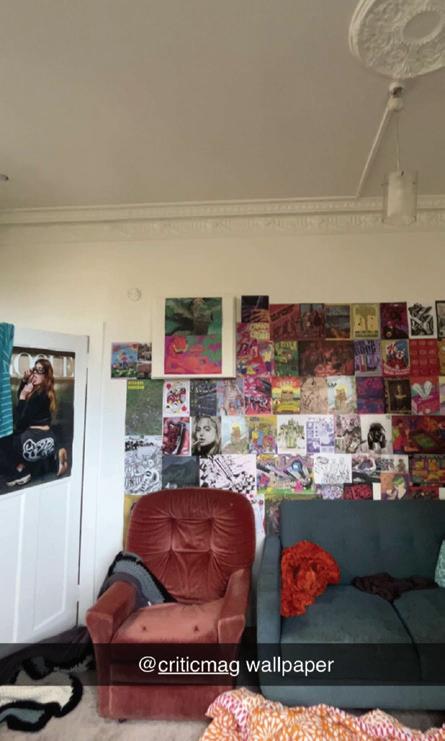















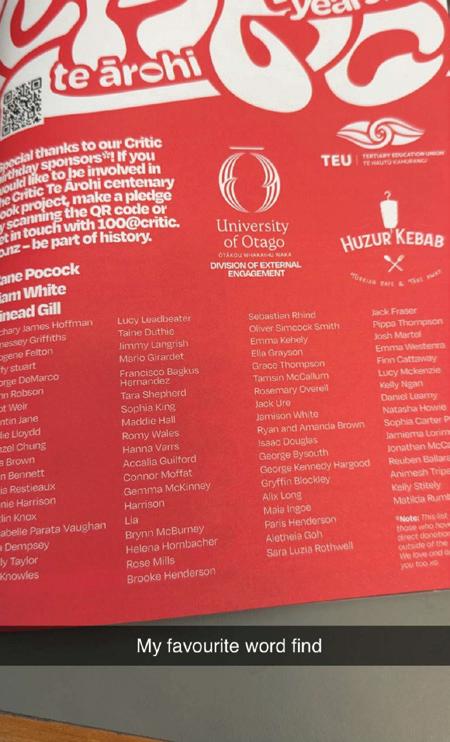
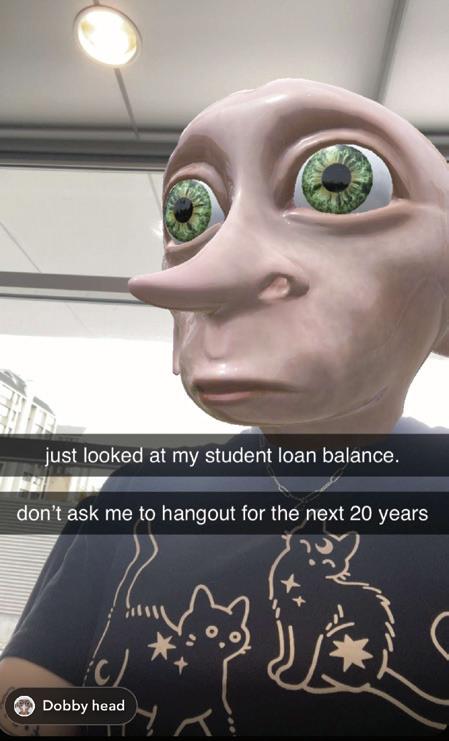


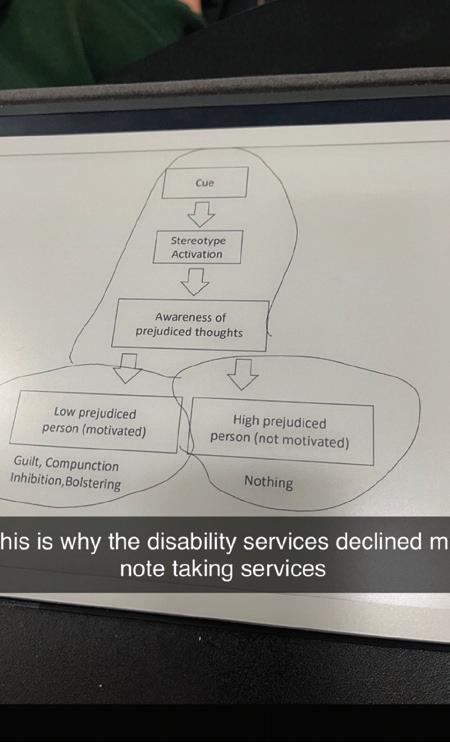
To commemorate 100 years of Critic, we're proud to announce a book proposal!


A centenary only happens once, and we need your help to make this project happen. Scan the QR code to check out the book proposal and details for pledges and donations